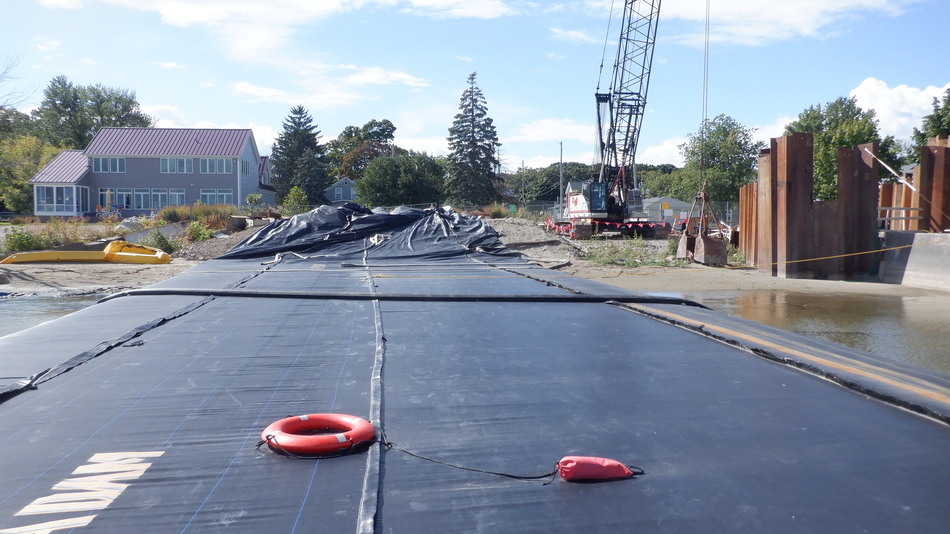
The first 14ft tall, 29ft wide (when filled), 450ft long single closed end (SCE) AquaDam® with a connection collar is installed. The open end is elevated at the starting bank. For successful installation, the starting bank must keep the open end higher than the dam’s max inflated height. The open end and fill-tubes must stay above the AquaDam®'s intended crest height. The AquaDam® will only reach its full height at the lowest elevation along its path.
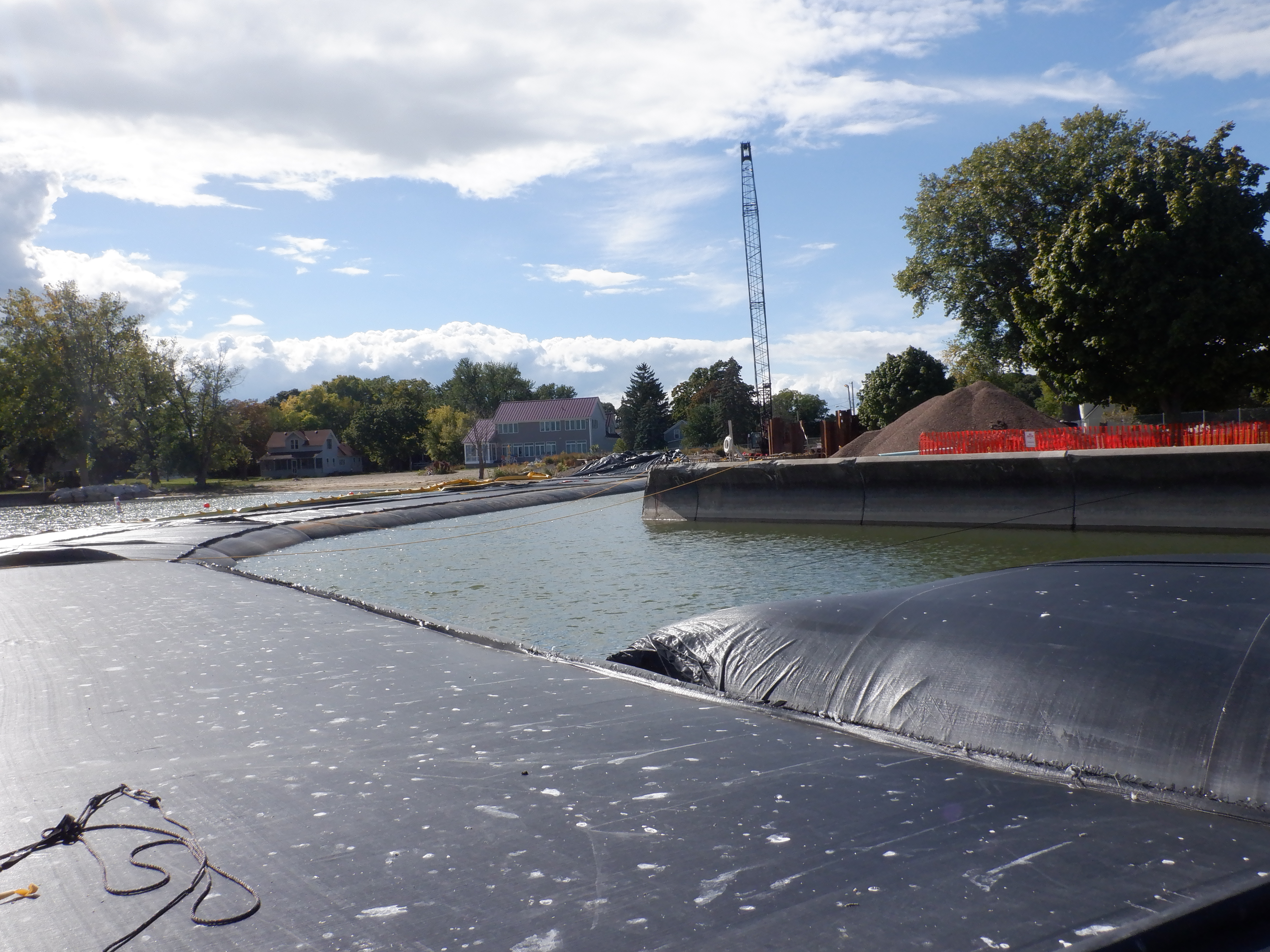
The 14ft tall SCE AquaDam® was maneuvered in the water during installation to align parallel with the seawall. As the unit was filled, ropes were secured from the seawall to the center seam atop the AquaDam® to assist with positional stability and alignment.
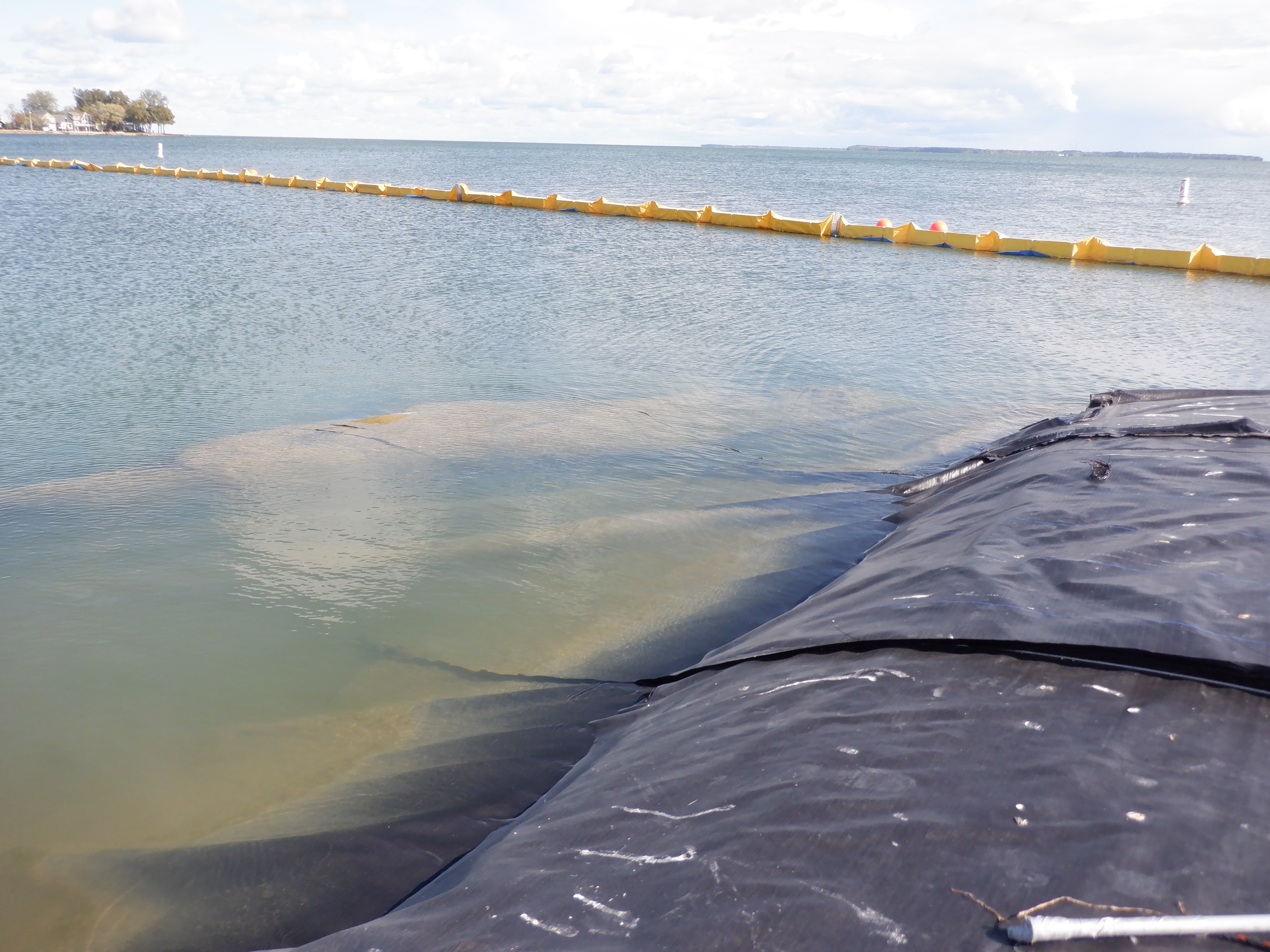
Barely discernible beneath the surface, the connection collar, which is attached to the closed end of the 14-foot SCE AquaDam®, has already accumulated sediment from the lakebed.
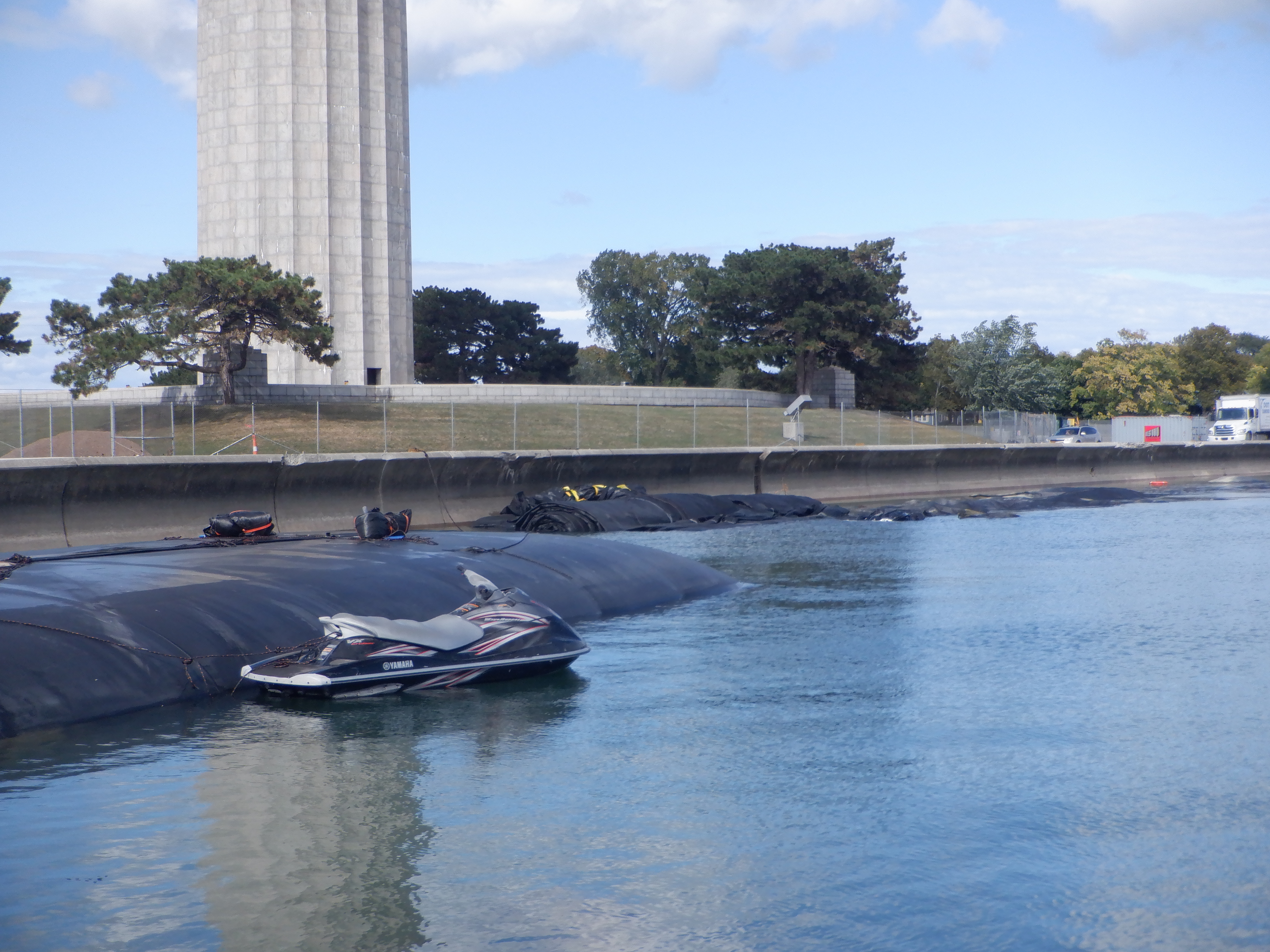
The second 14ft tall, 450ft long SCE AquaDam® has been deployed into the water. At this stage, the unit remains rolled up and is visibly floating adjacent to the sea wall, awaiting alignment and filling.
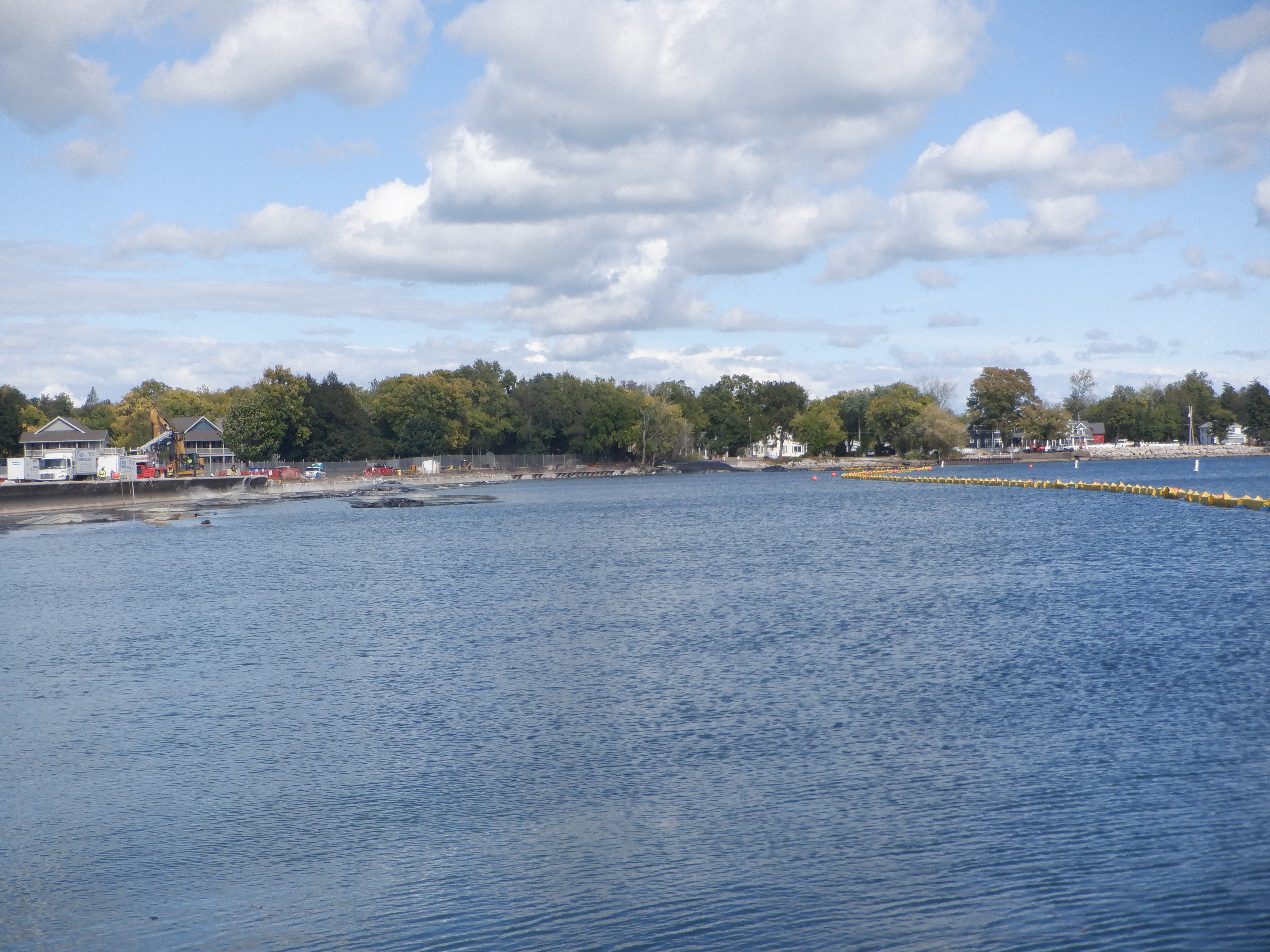
Dewatering and repair of the entire seawall on the left was necessary.
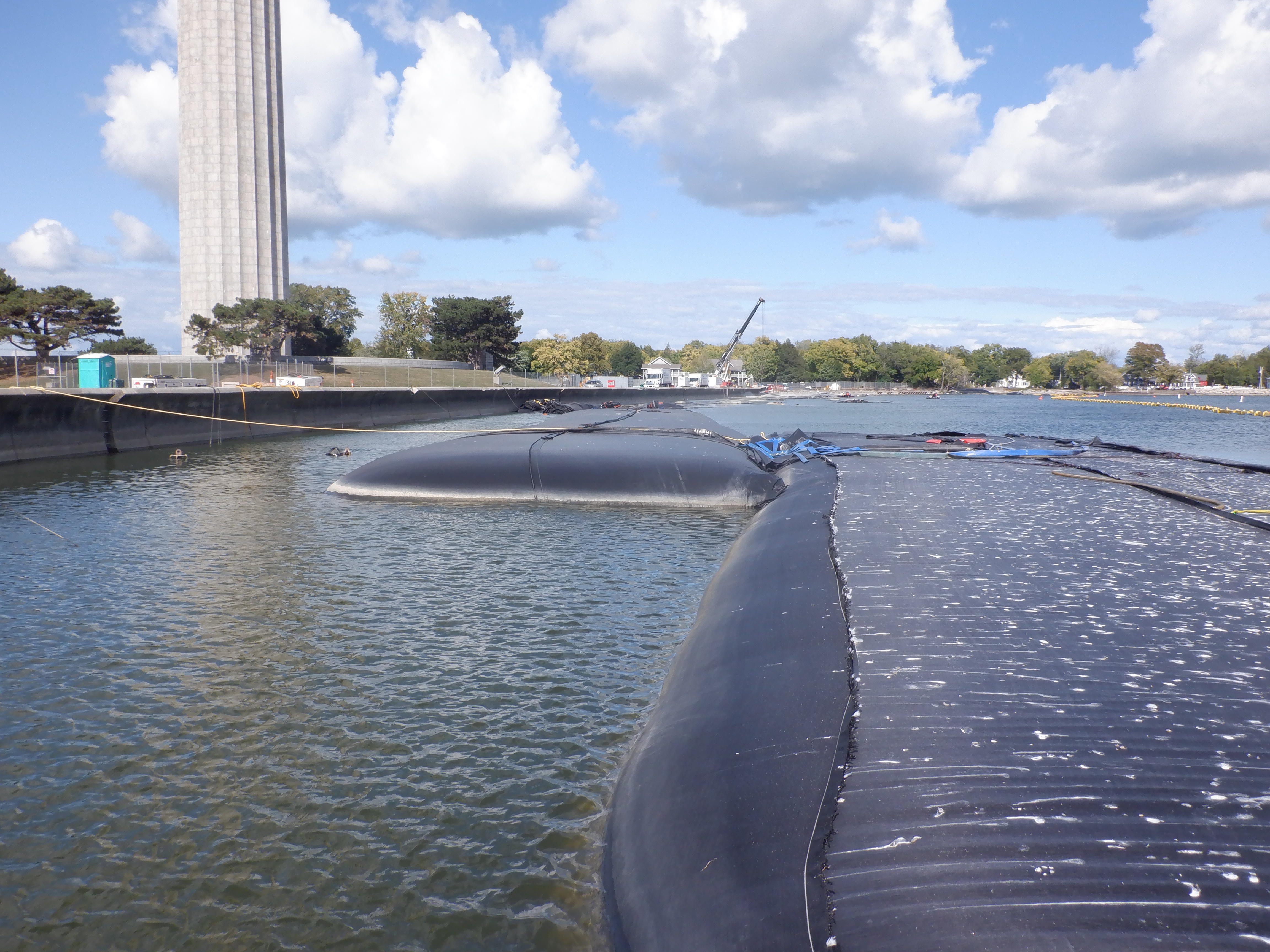
To ensure the integrity of the continuous cofferdam formed by four interconnected AquaDams®, each junction was bolstered by a dedicated support AquaDam®. These support AquaDams® were precisely positioned: half their length abutted the closed end of a primary AquaDam®, while the remaining half extended to the open end of the adjoining primary AquaDam®, specifically at the connection collar.
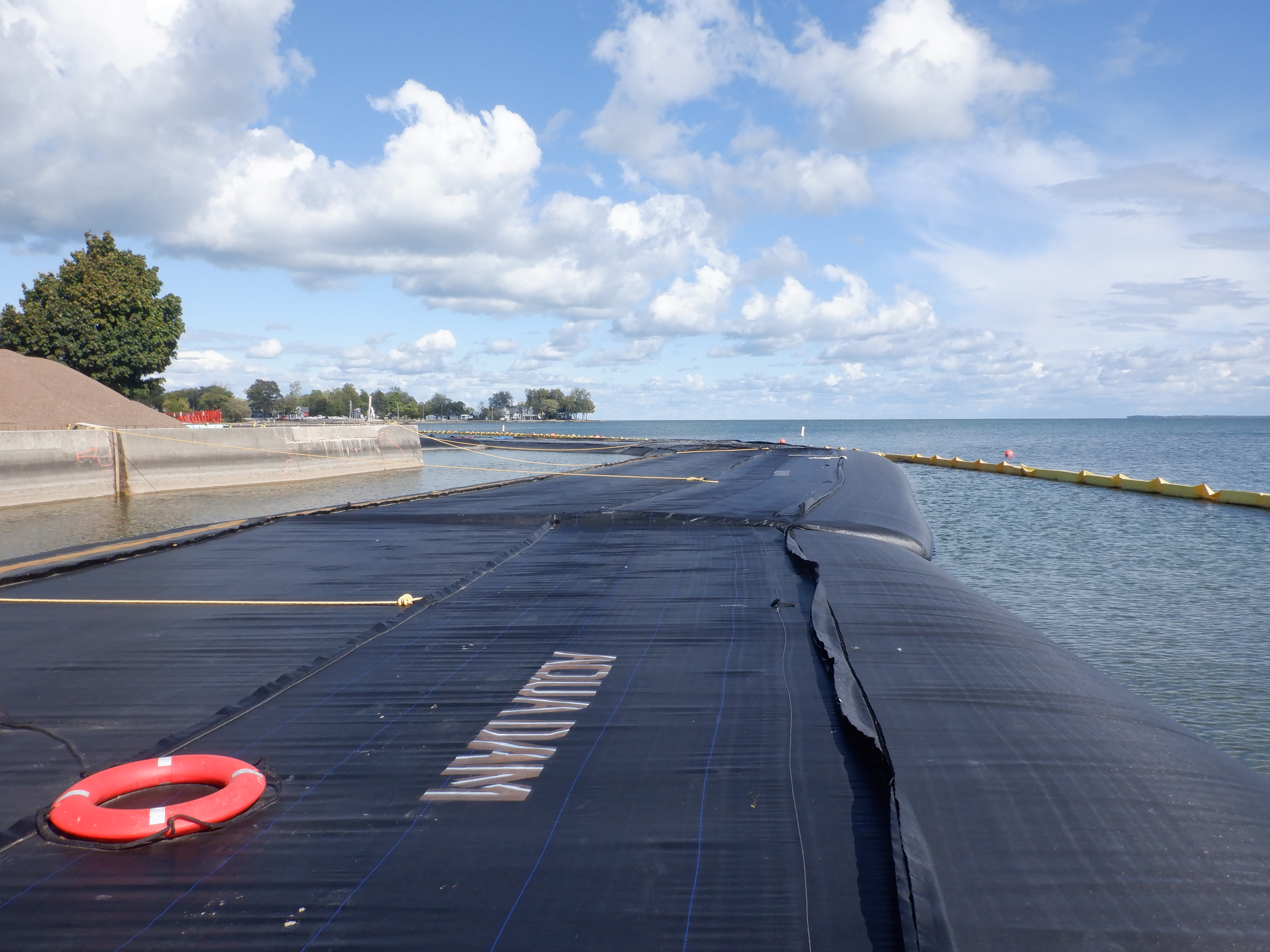
Several hundred feet of rope were utilized to maintain AquaDam® positioning during the water-fill process. These ropes provided critical guidance and restraint, helping stabilize the dam and control alignment as its internal chambers were filled. Once the AquaDam® reached its rated full height and settled into position, most of the ropes were no longer required and could be safely removed.
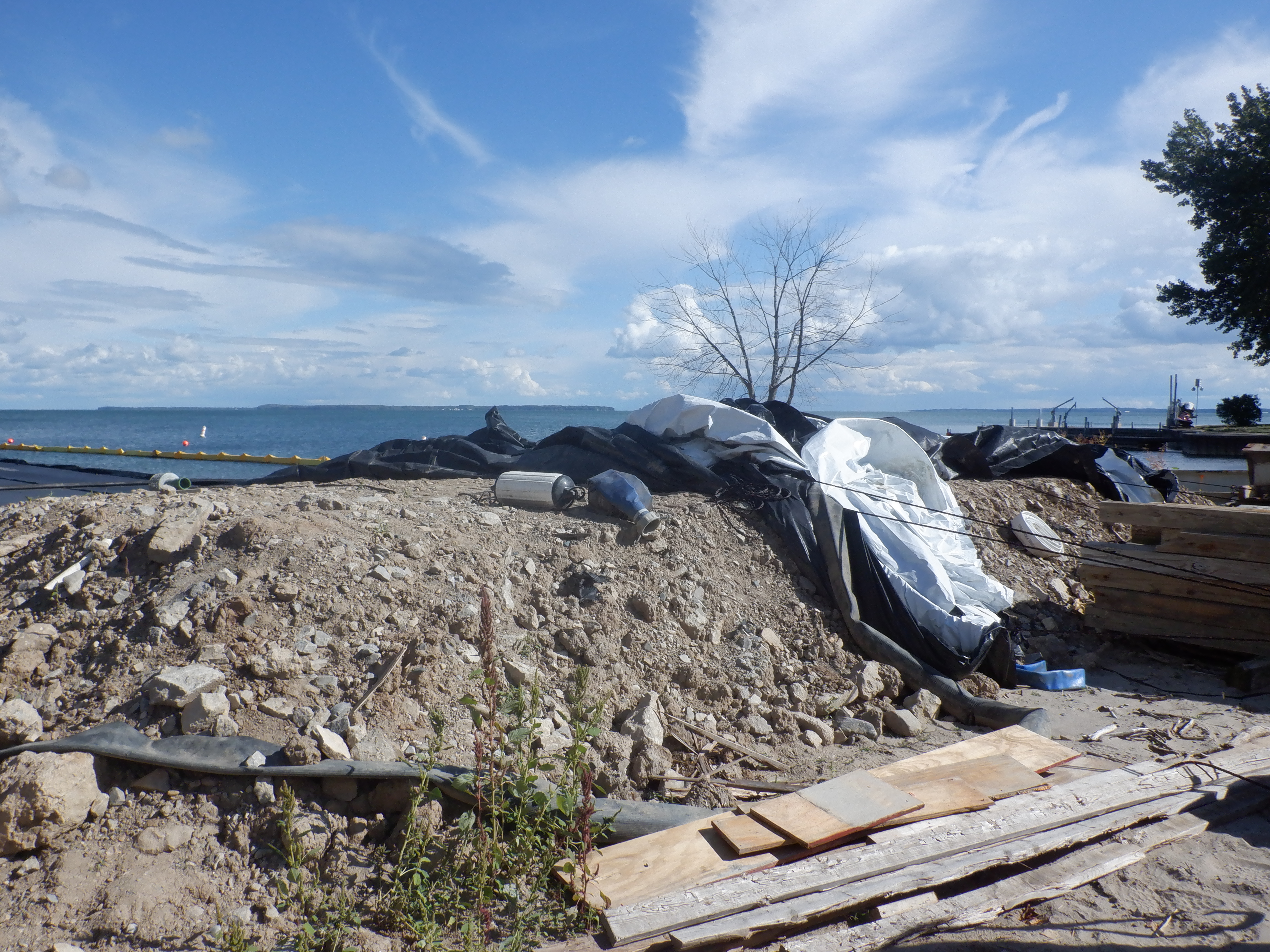
The fill-tubes of the first 14ft tall SCE AquaDam® can be seen here draped over the backside of its starting bank. Ropes were secured from the open end to concrete anchor blocks to prevent the material from slipping or rolling down the bank.
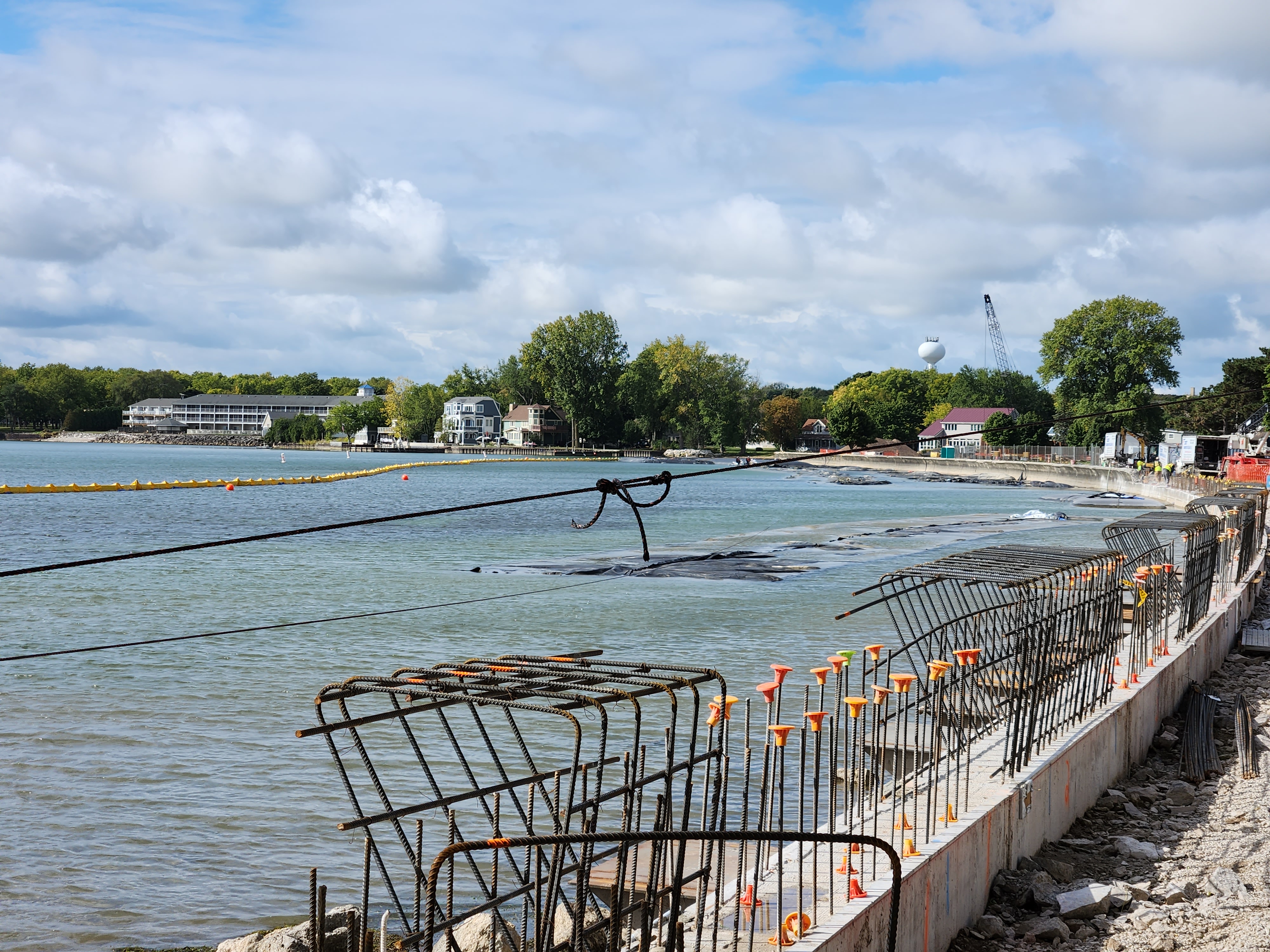
Several AquaDams® had previously been deployed at this location and subsequently washed out. To recover and reuse the viable units, workers reorganized them on site to enable proper redeployment. Once an AquaDam® becomes flaccid and no longer maintains contact with the bottom of the waterway, it can be manually re-positioned, pulled or pushed into the desired alignment prior to refilling.
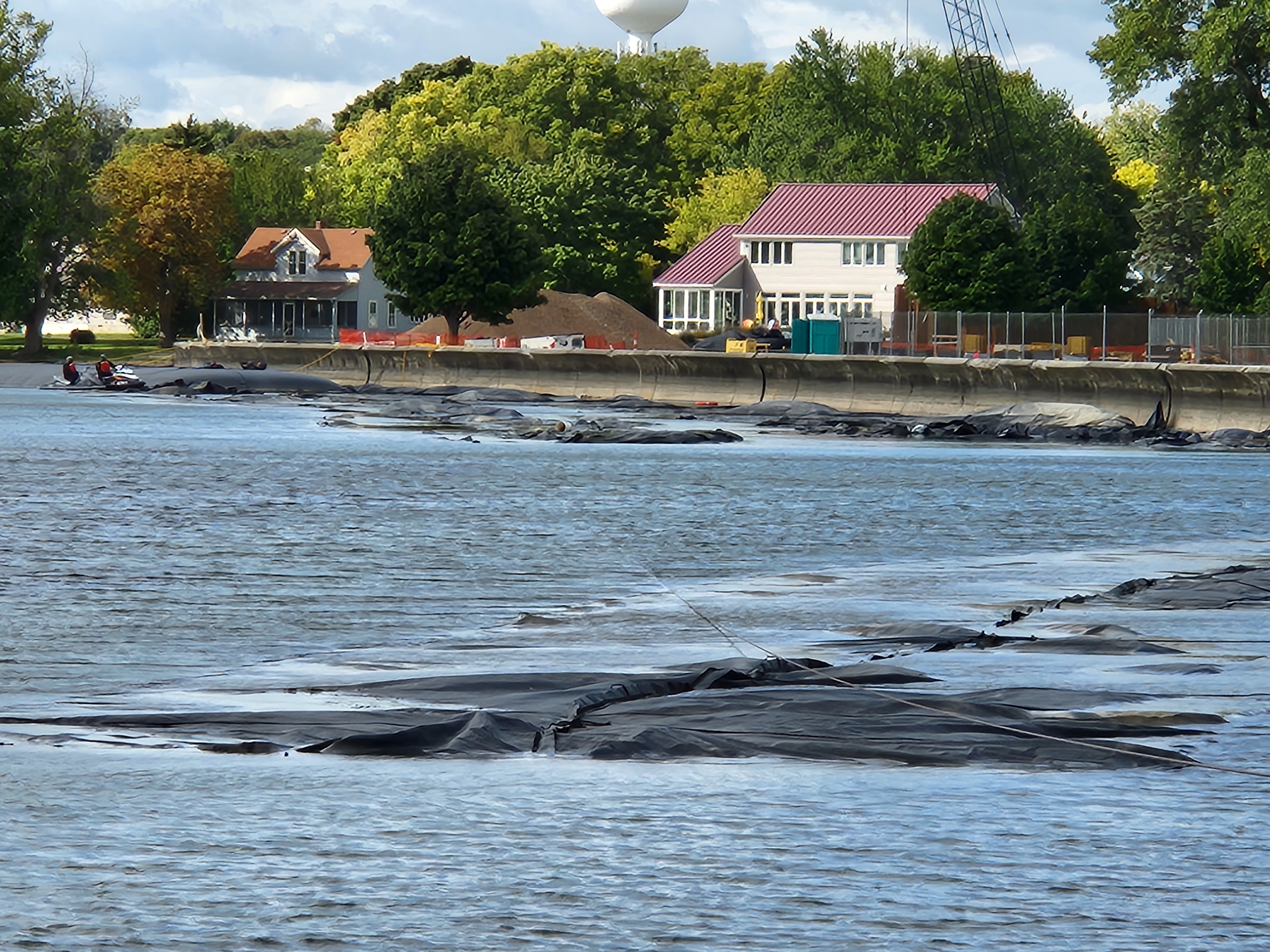
To prepare for the new temporary cofferdam system, personnel identified reusable AquaDams® and cleared the designated installation path. AquaDams are manufactured from lightweight, pliable materials, allowing them to remain buoyant when deflated in adequate water depths.
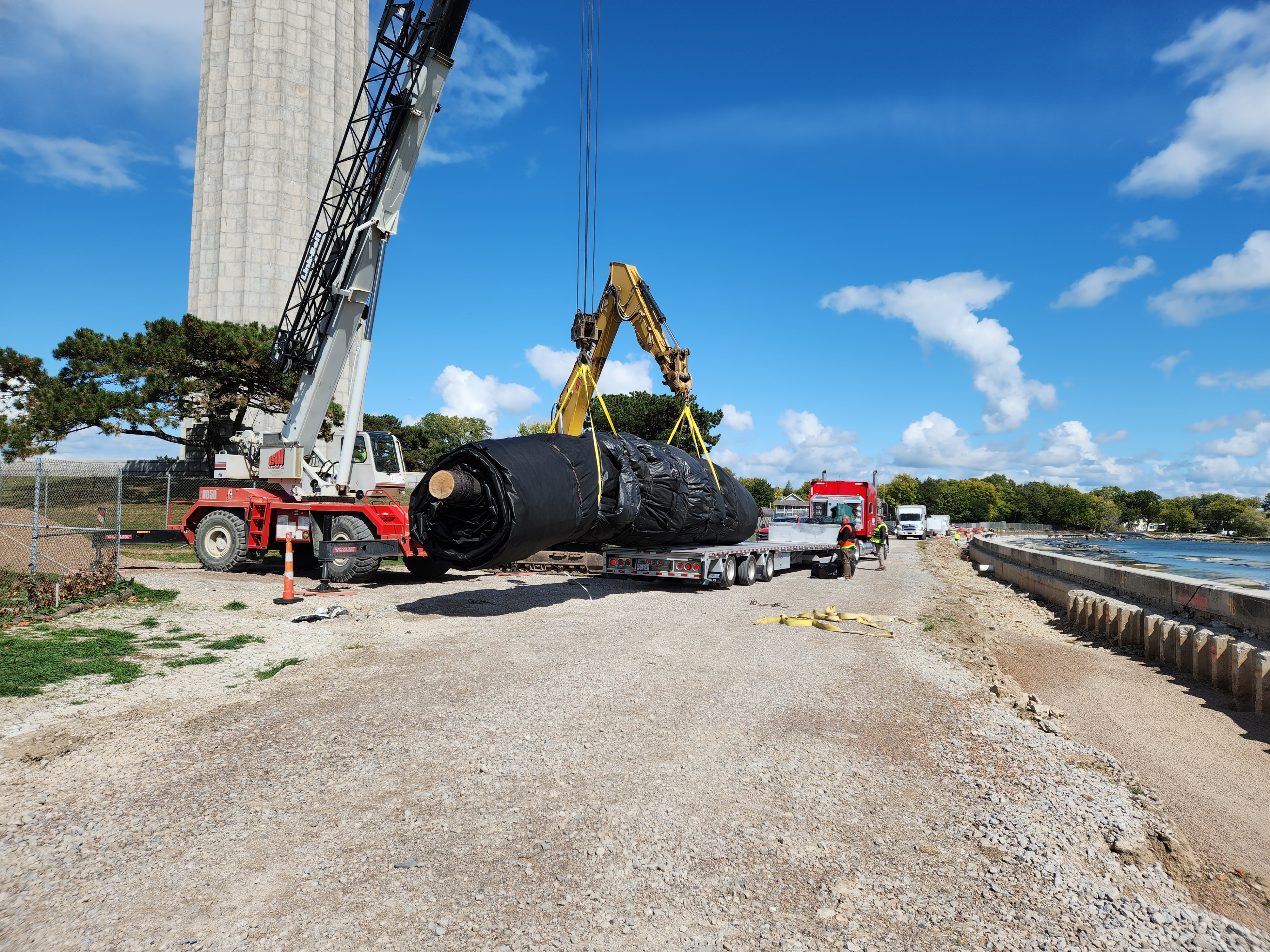
AquaDams® are shipped rolled up like a carpet on a wooden beam, enclosed in protective wrapping to safeguard the material during transit. Each unit is equipped with lifting ropes or straps to facilitate handling and placement. In this instance, the protective covering has already been removed, and the dam is ready for deployment.
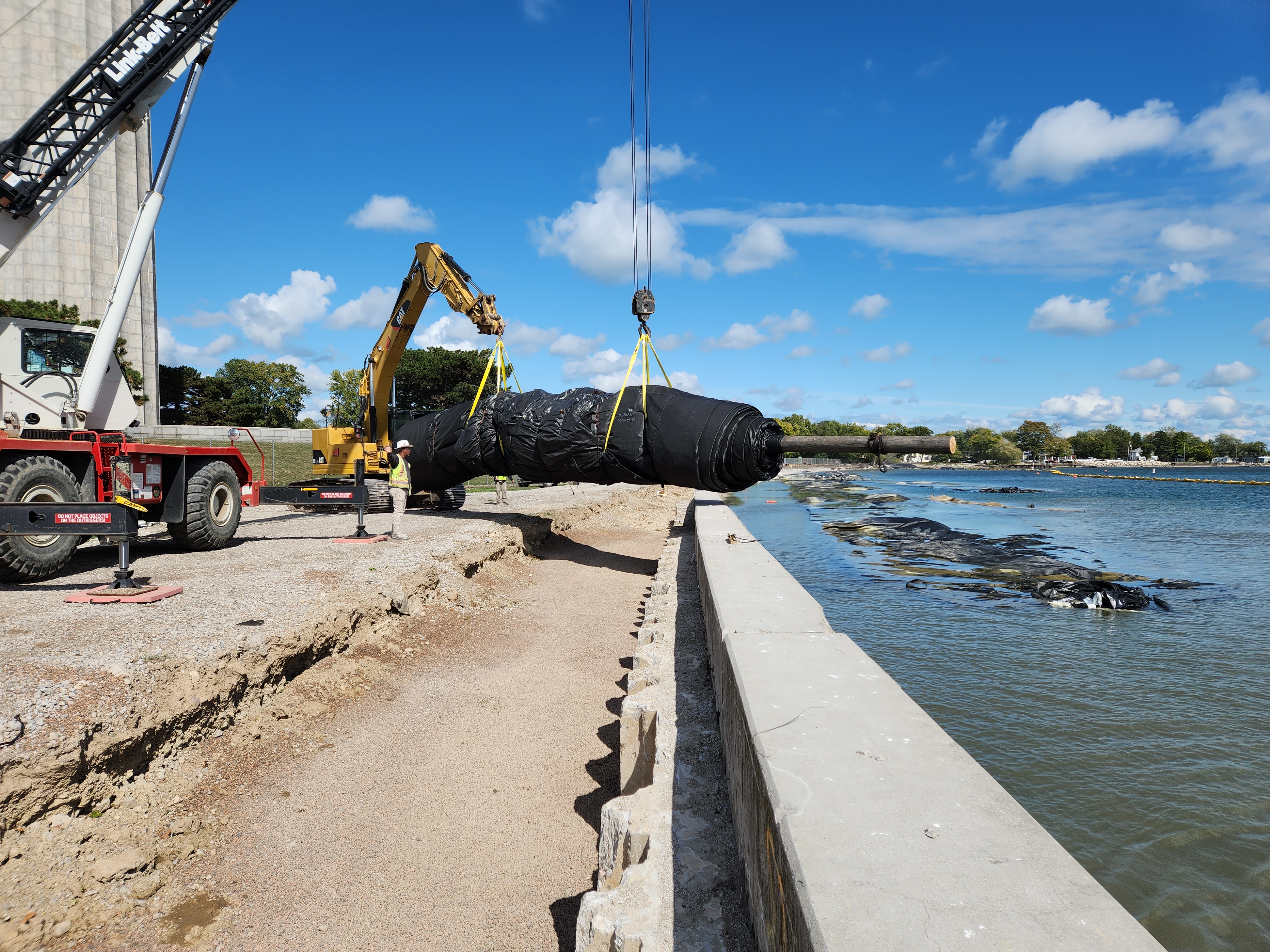
The lifting straps have been strategically spaced to evenly distribute the load during hoisting. This spacing helps prevent concentrated stress on any single area of the AquaDam®, reducing the risk of material damage and promoting safer, more controlled handling.
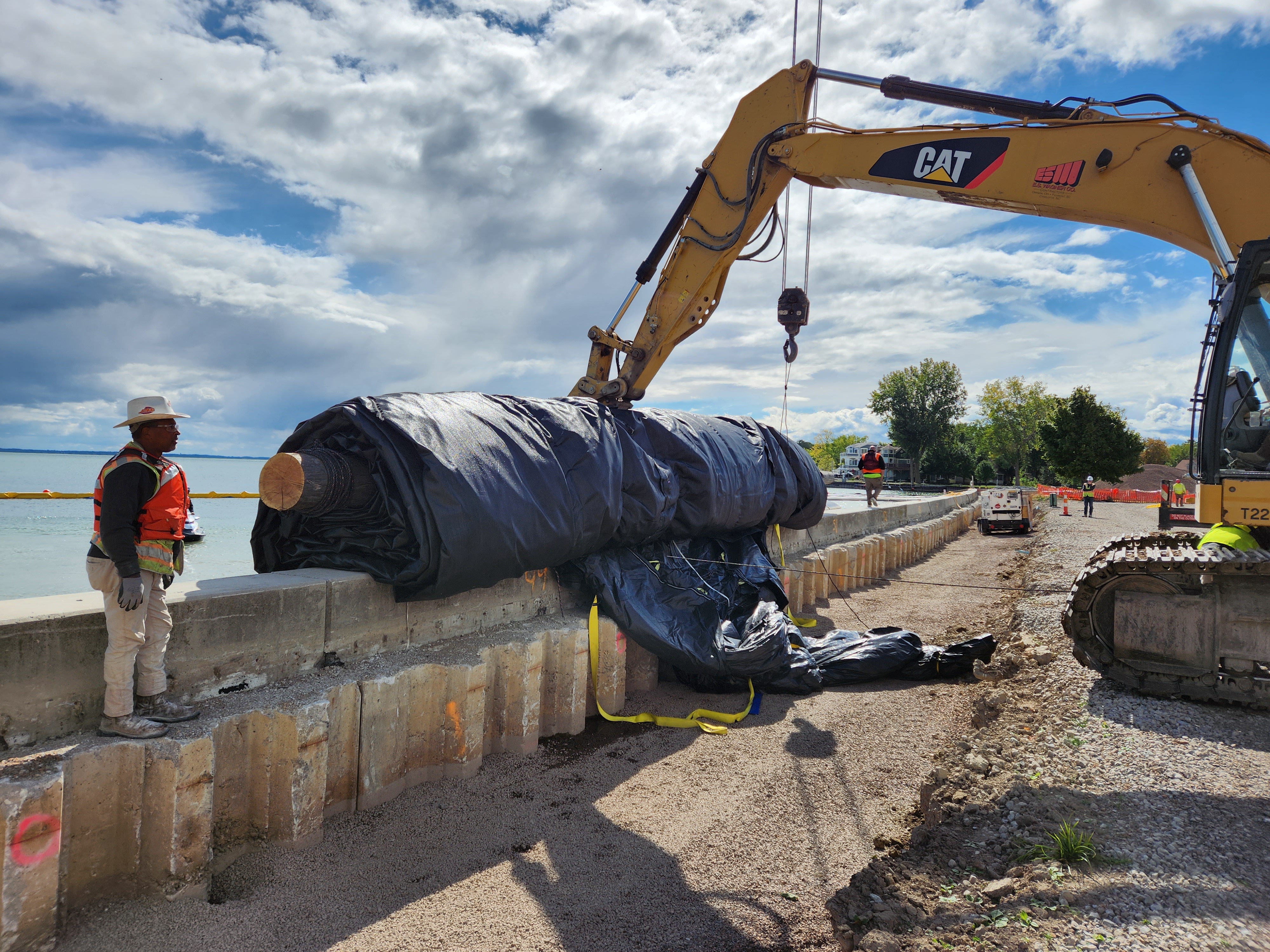
In preparation for its deployment into Lake Erie, the second 14ft tall SCE AquaDam® has been placed atop the seawall. Personnel have unrolled the unit to it's fill-tubes, ensuring the fill-tubes can be readily inserted into the connection collar of the initial 14ft tall SCE AquaDam®.
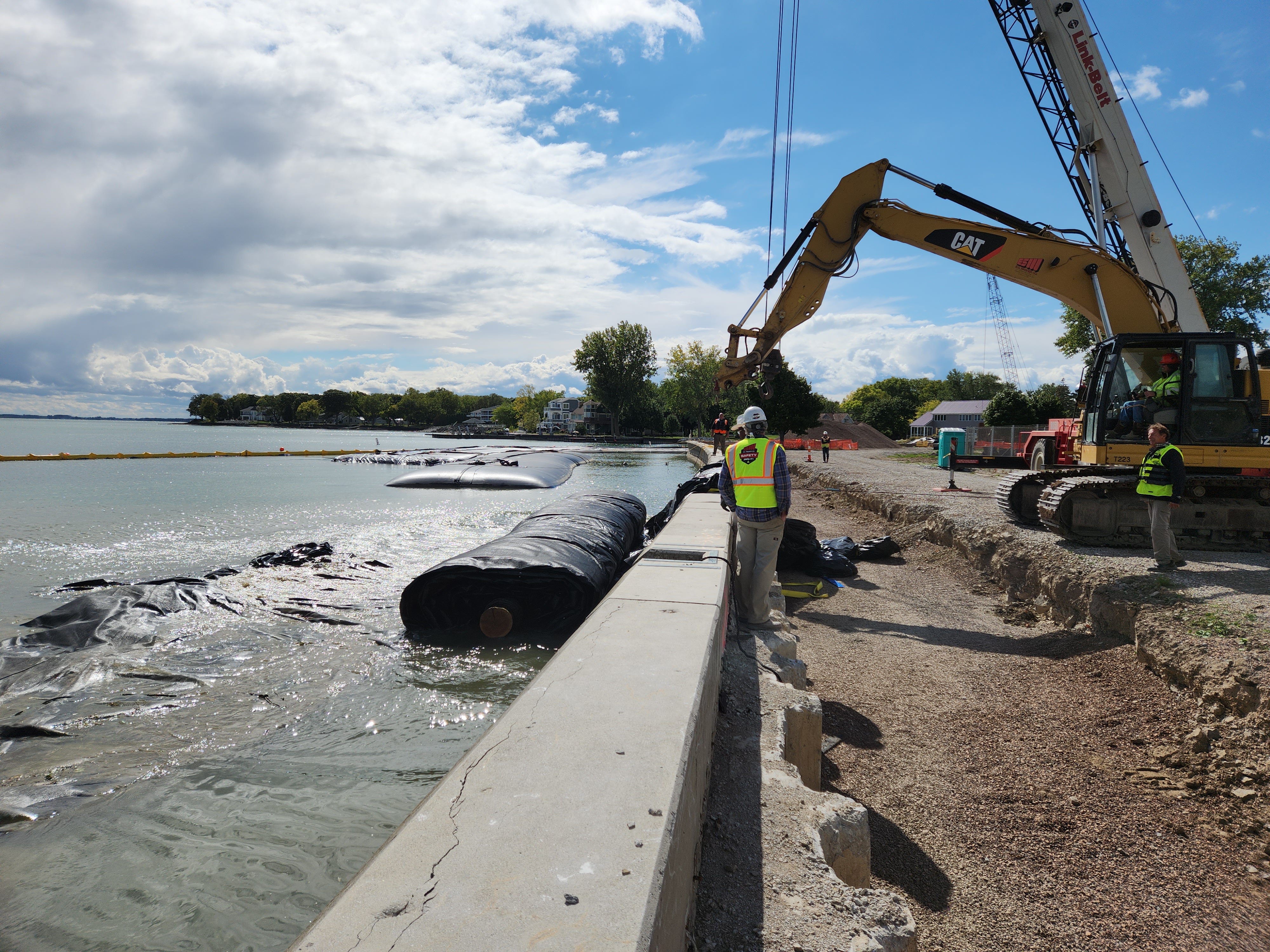
The 14ft tall SCE AquaDam® has been deployed into the water.
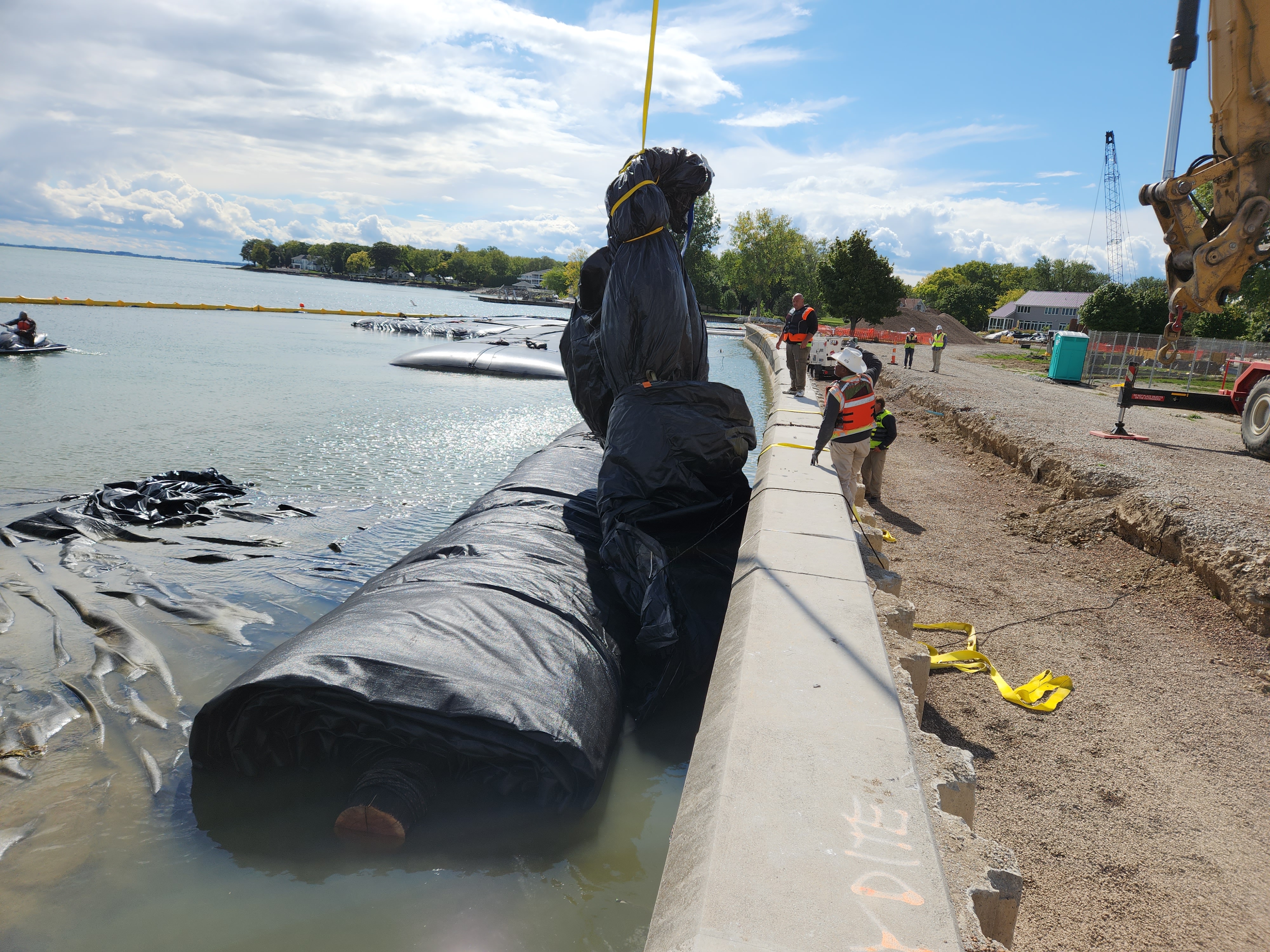
To facilitate the connection process, workers gathered the fill-tubes and open end of the AquaDam® into a compact bundle. This method helps reduce material resistance and improves alignment, allowing the components to be more easily inserted into the adjoining unit’s connection collar.
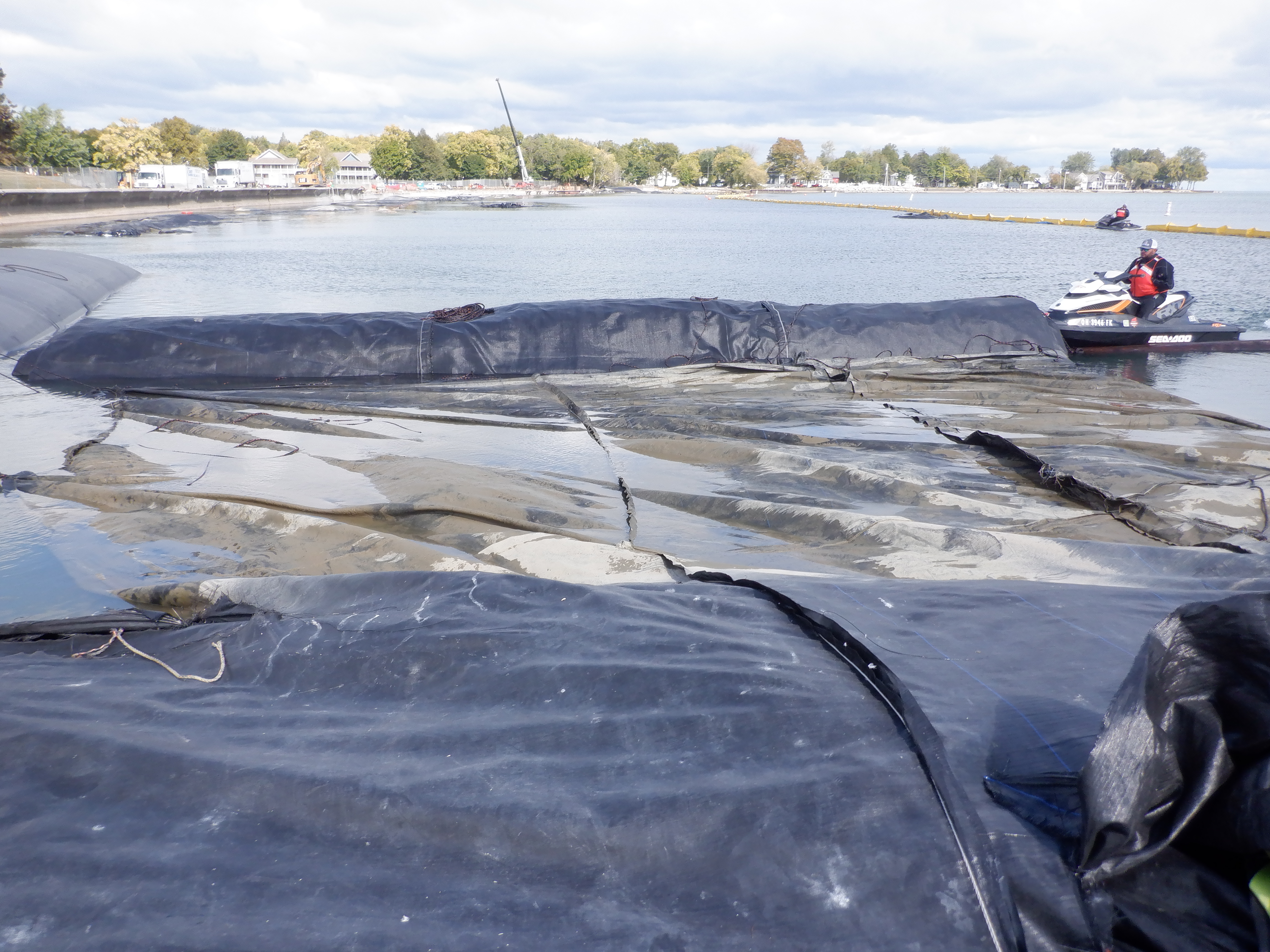
The first connection has been established, and the second 14ft tall SCE AquaDam® is now undergoing its filling process. Observe the residual silt adhering to the connection collar.
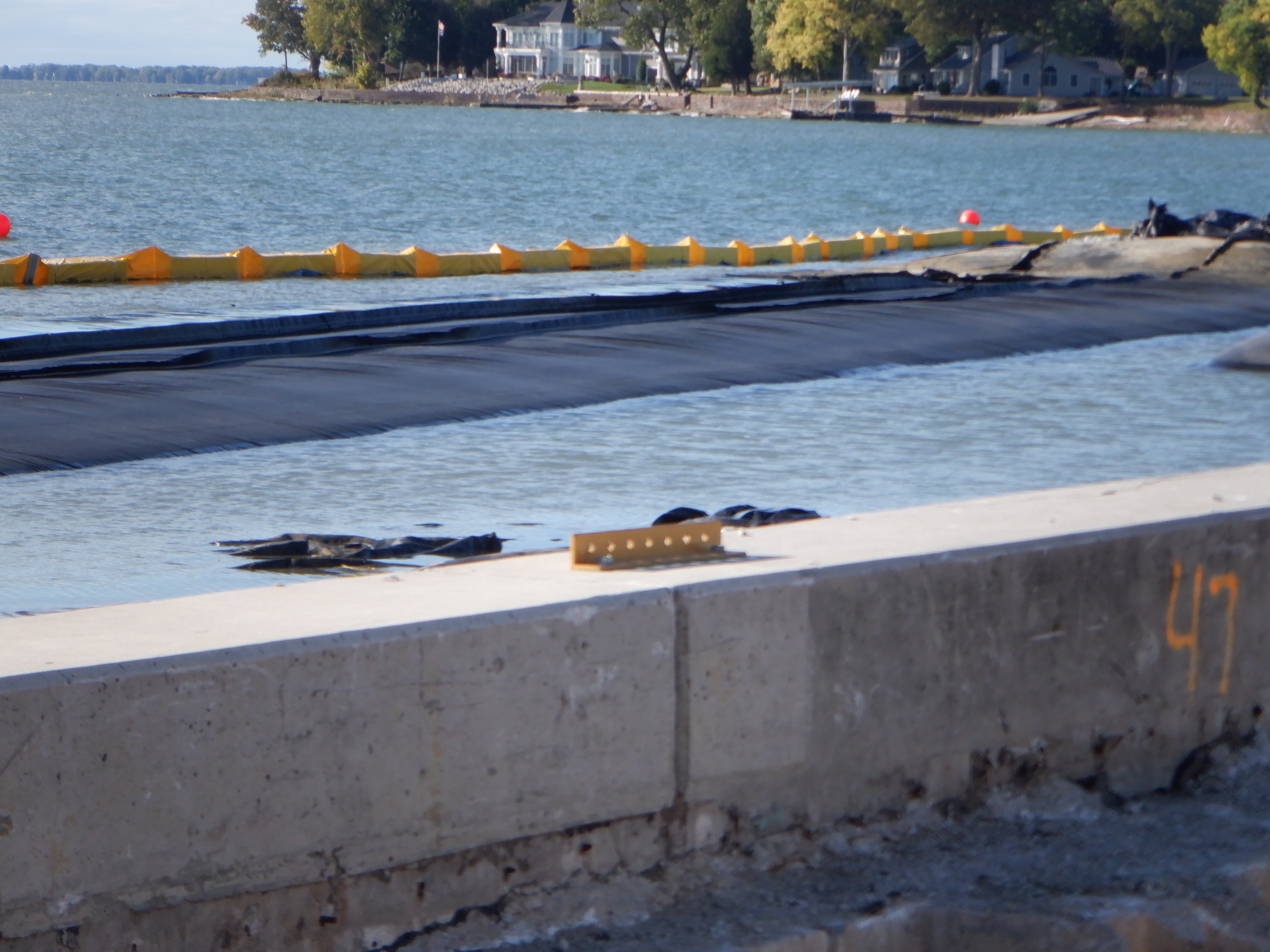
The second 14ft tall SCE AquaDam® continues to fill. As water is introduced, the internal pressure causes the dam to gradually unroll. Workers use ropes to control the unrolling process, ensuring that the internal water level, and resulting hydrostatic head, remains higher than the surrounding water to maintain stability.
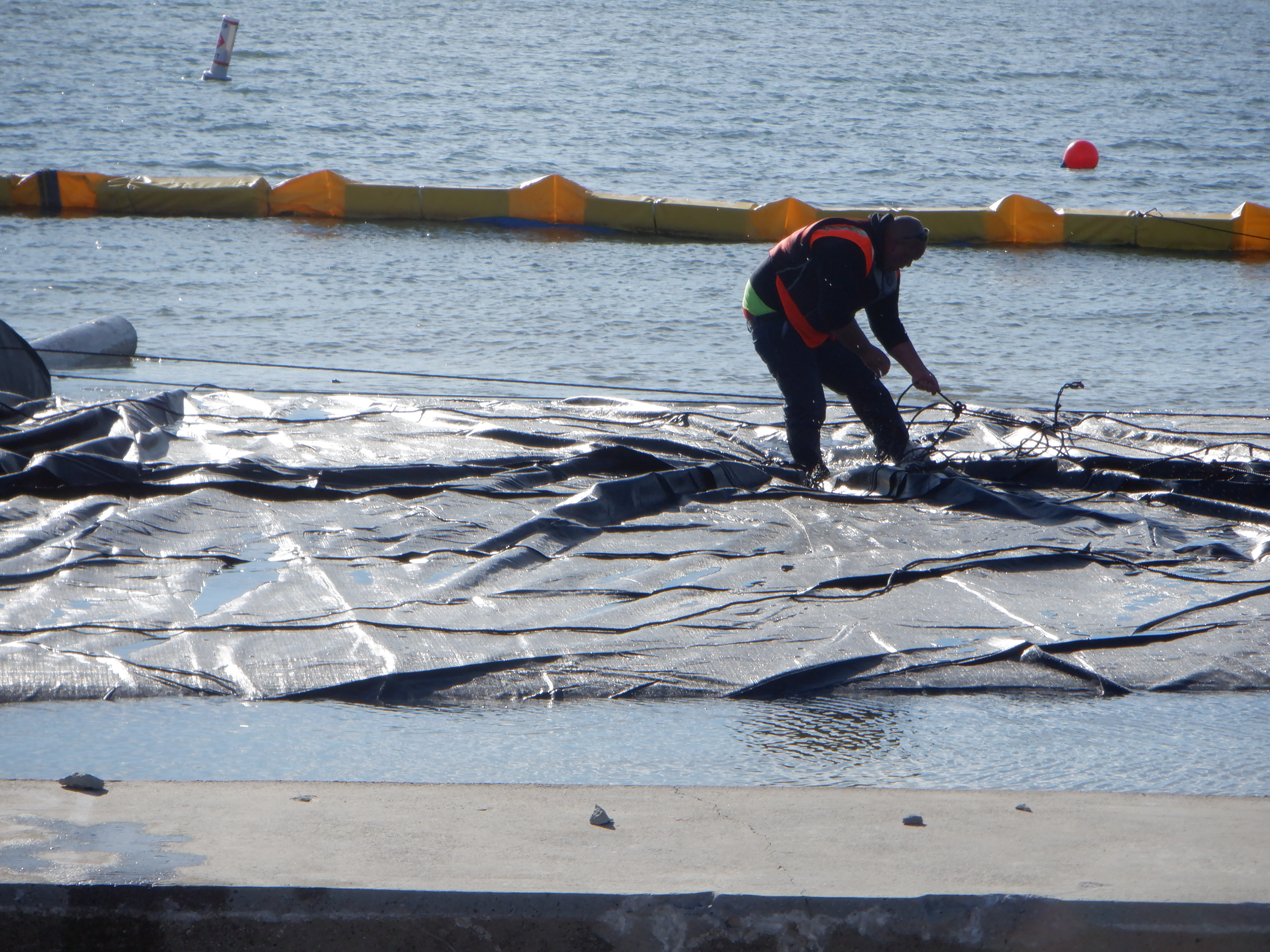
A worker has secured a slip knot to the top and bottom seams of the AquaDam® to hold the rolled section in place while the unrolled portion fills. Once the dam's body achieves sufficient head above the surrounding water, the worker will release a few feet of rope, allowing the roll to extend before re-securing the slip knot.
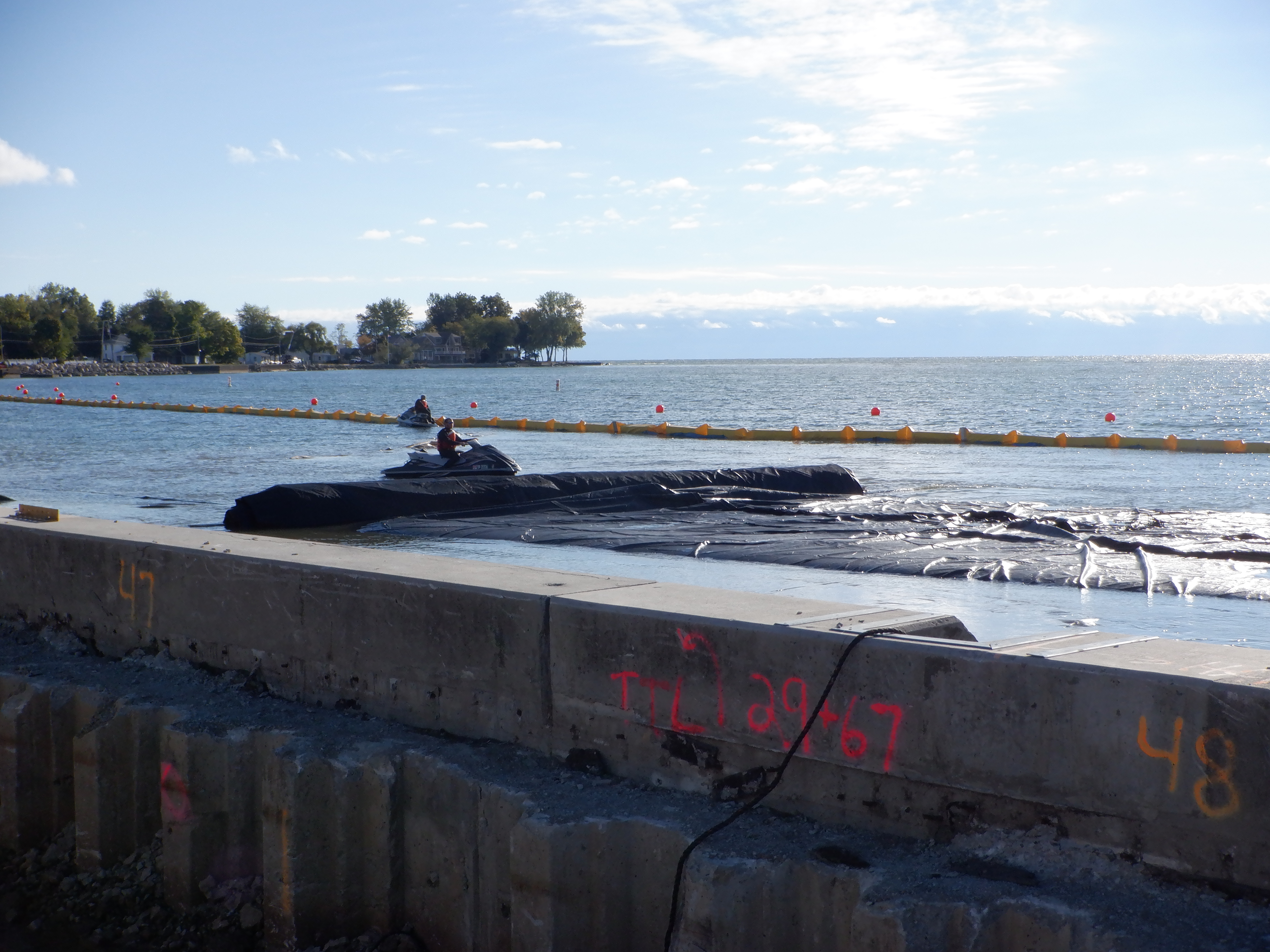
Workers operating jet skis were also utilized to apply pressure on the roll, helping to prevent premature unrolling during deployment.
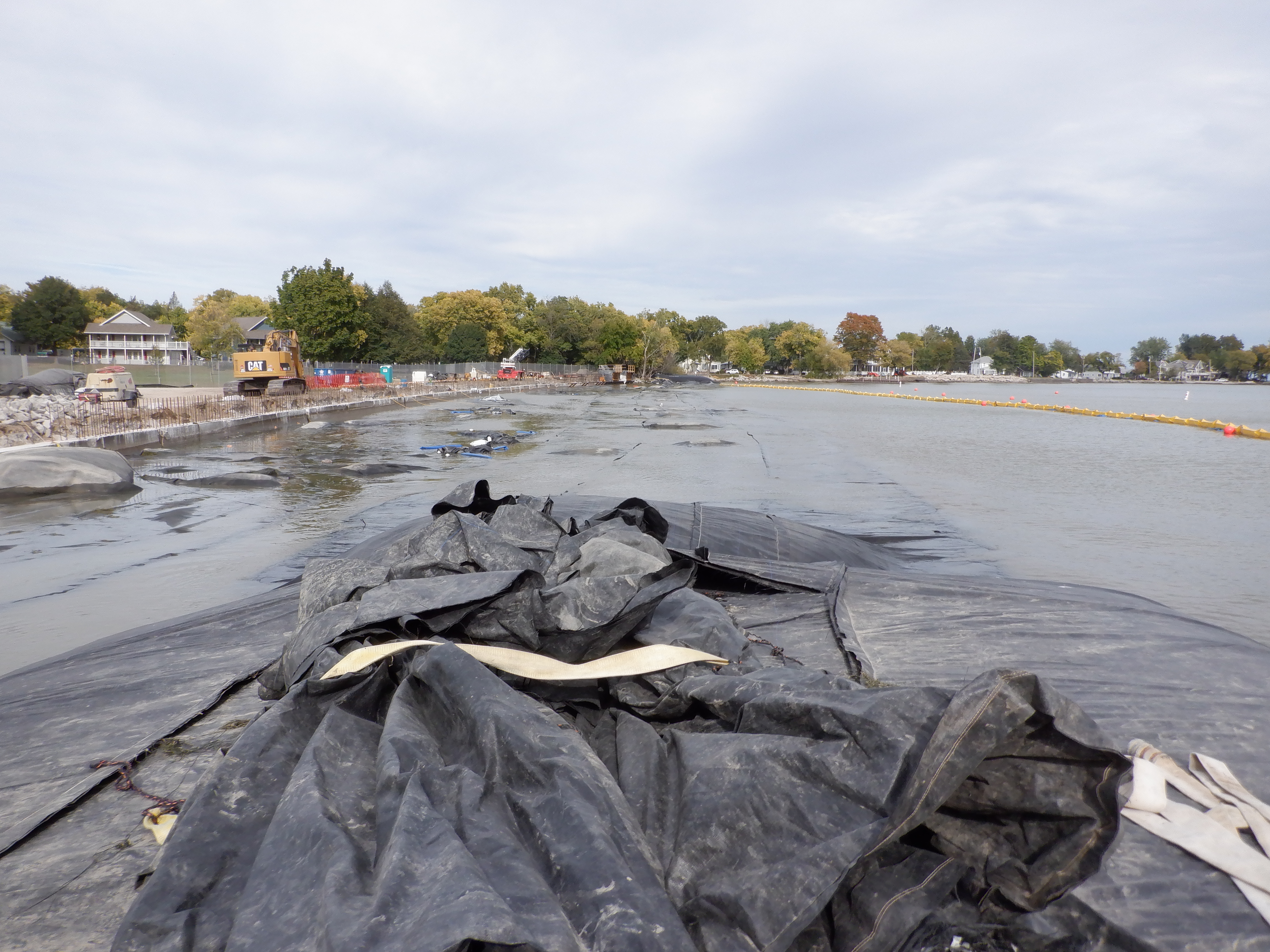
The open end of the third 14ft tall SCE AquaDam® is now visible after being carefully guided through a custom-cut opening in the connection collar of the second SCE unit. This interlinking configuration allows seamless extension of the dam system. The third AquaDam® is currently being filled with water sourced directly from Lake Erie, initiating expansion and structural engagement with the connected unit.
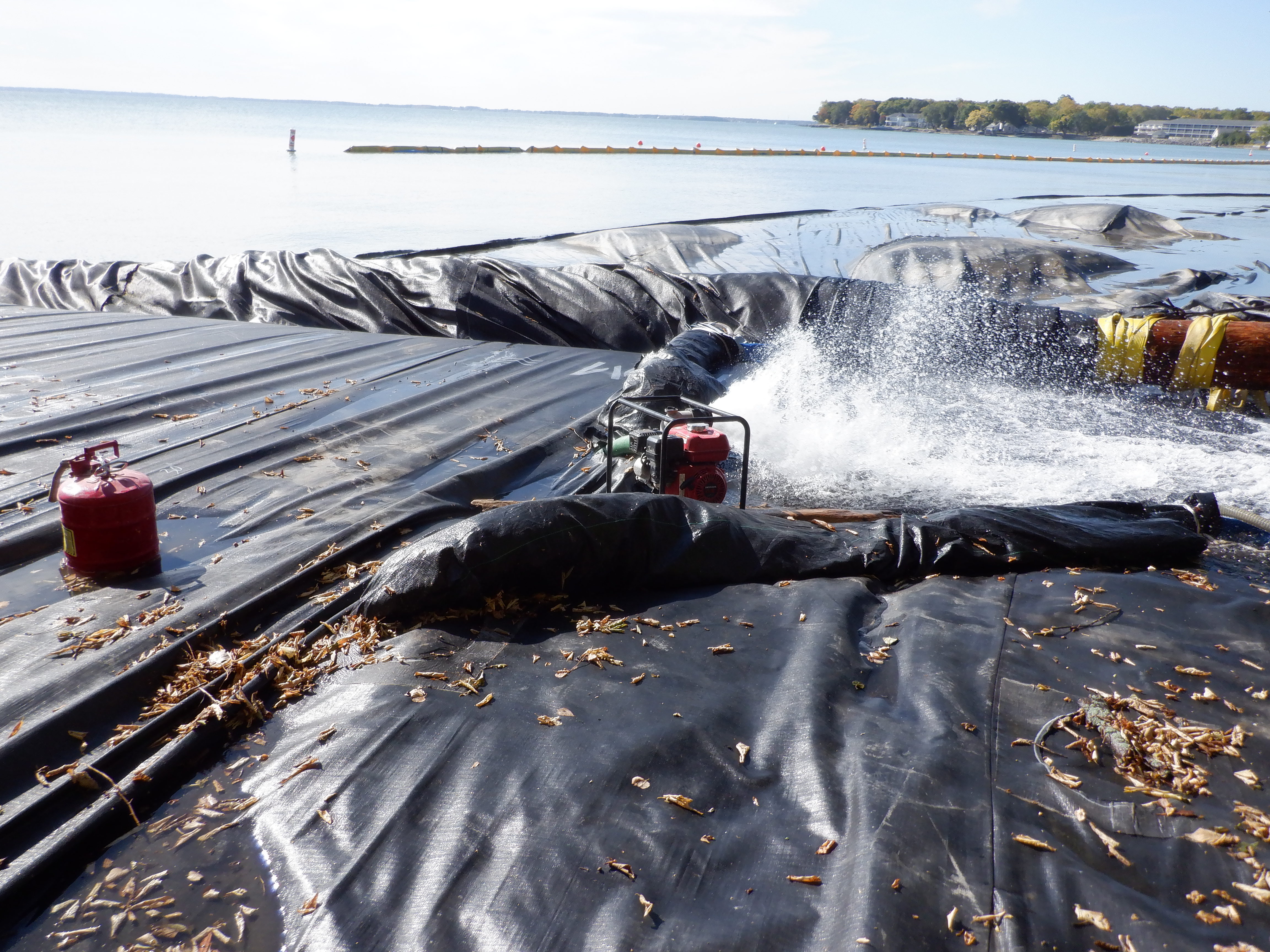
To accommodate the fourth 14ft tall SCE AquaDam®, a double closed end (DCE) AquaDam® (12ft tall, 25ft wide, 50ft long) was deployed due to lack of a sufficient bank. This provided the elevation and surface area for alignment and termination. Crews partially drained the DCE AquaDam® to allow seamless contact and structural integration with the SCE unit.
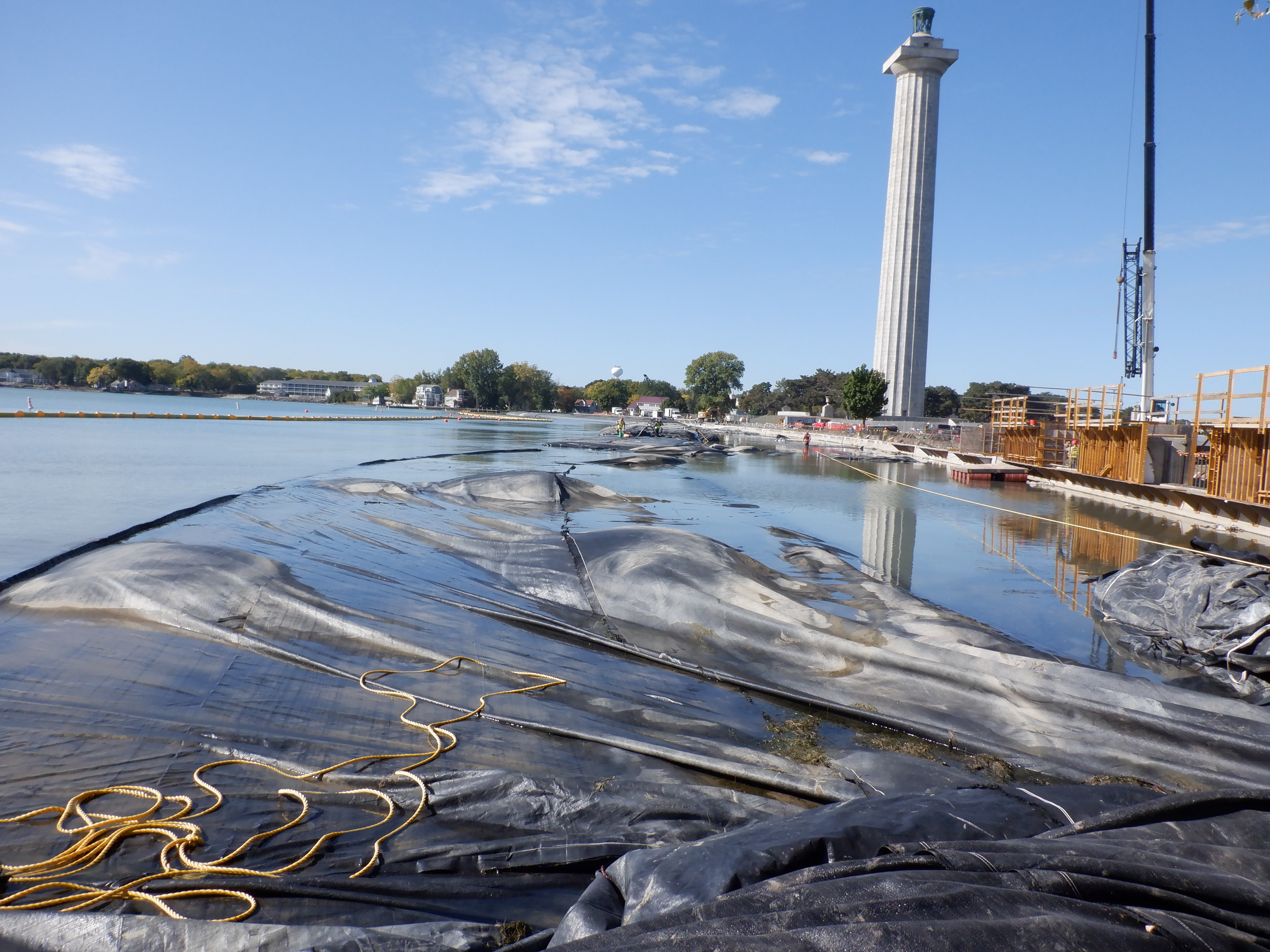
Workers maneuvered the fourth 14ft tall SCE AquaDam® into deeper water to improve handling and positioning. This allowed them to more efficiently guide its open end and fill-tubes into the connection collar secured to the closed end of the third 14ft tall SCE AquaDam®.
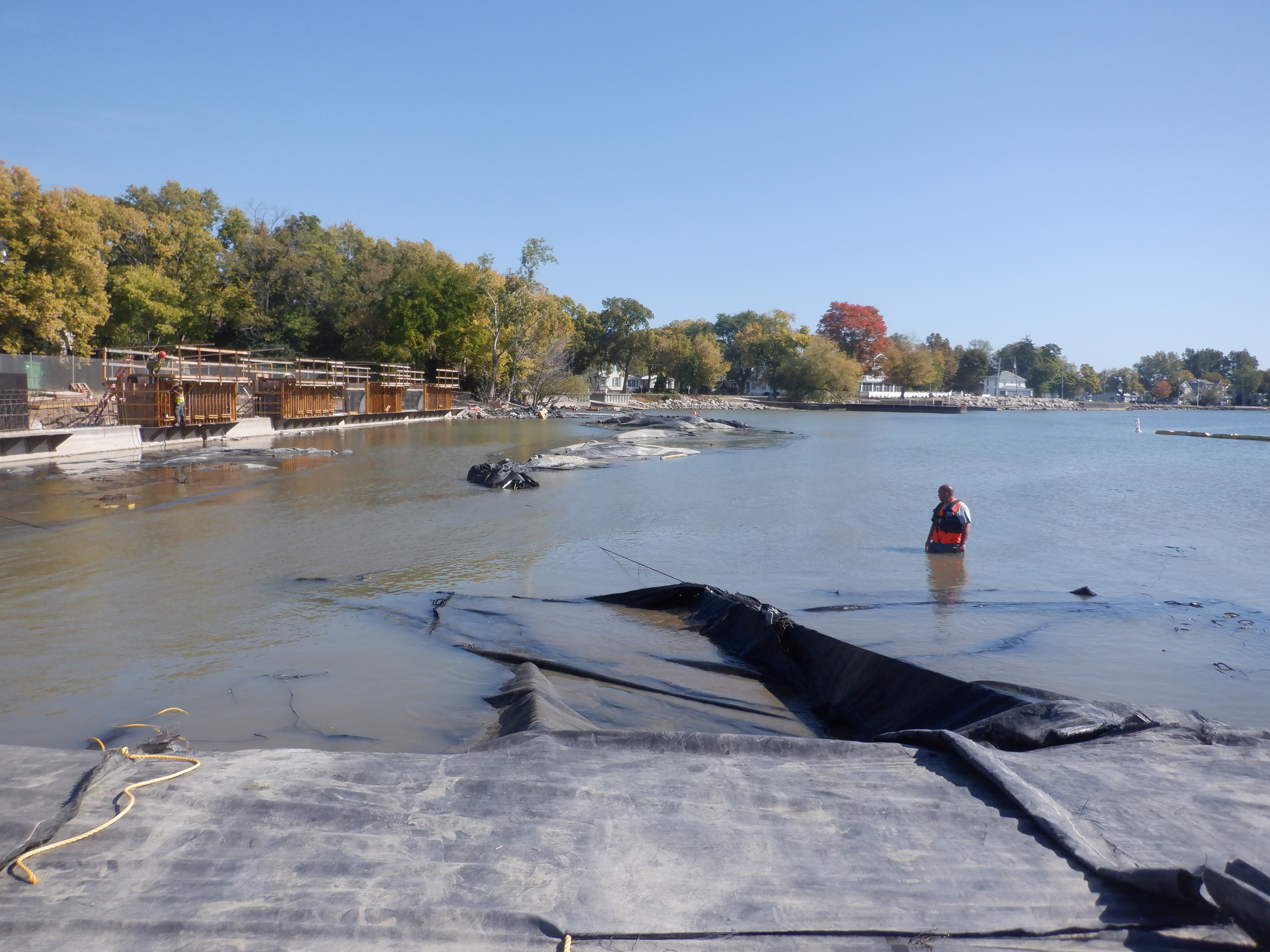
The open end and fill-tubes of the fourth 14ft tall SCE AquaDam® were gathered and tightly secured using rope. Additional rope was affixed to the bunched material, allowing crews to guide the end through the connection collar of the third AquaDam® for alignment and secure positioning.
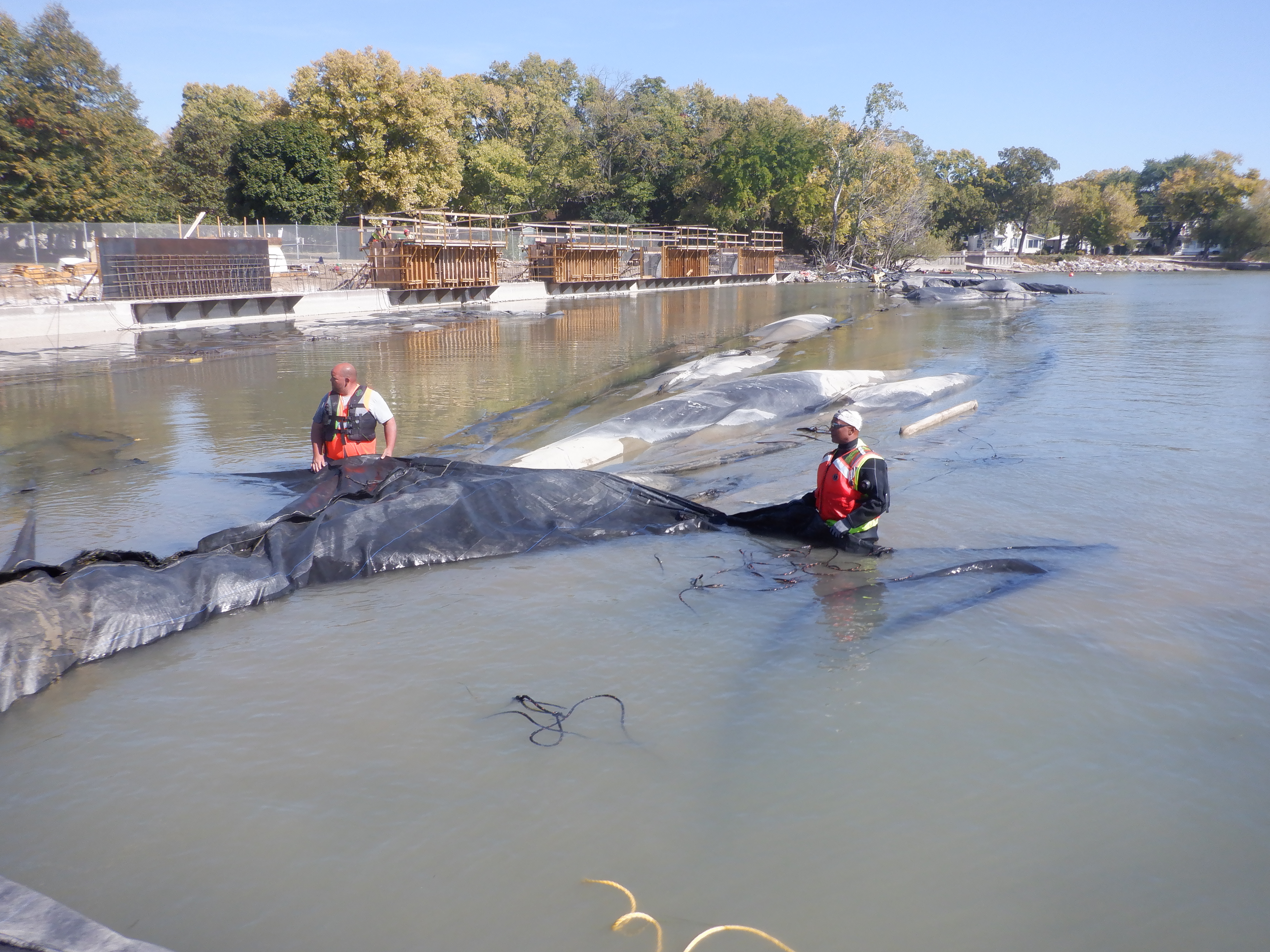
Workers kept the connection collar open as the next AquaDam® was pulled into position.
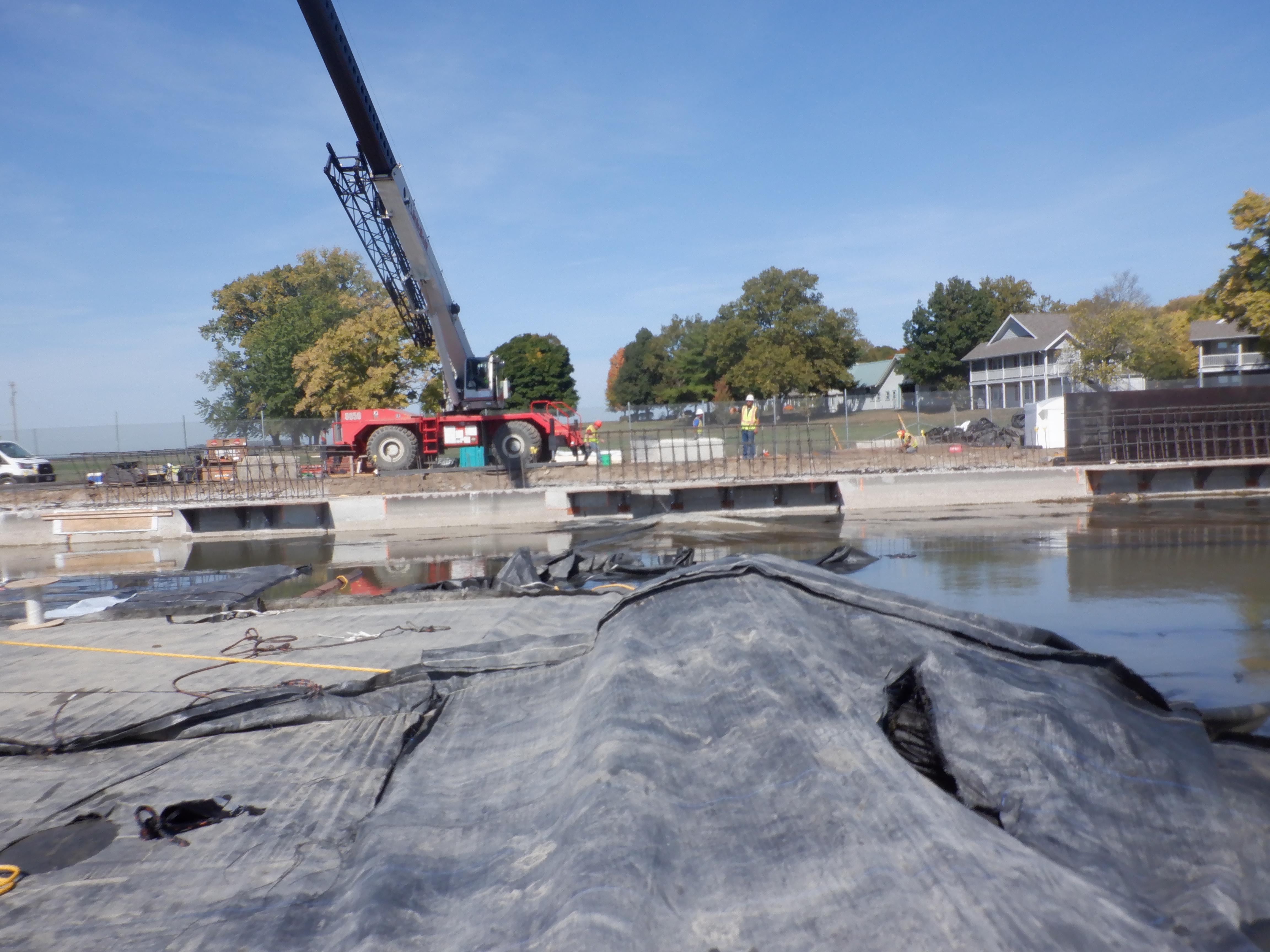
The open end and fill-tubes must be lifted and positioned atop the closed end within the connection collar. Once properly aligned, the fill-tubes will be drawn out through the access hole, guided by the yellow rope (seen in tension) to ensure controlled placement and secure orientation.
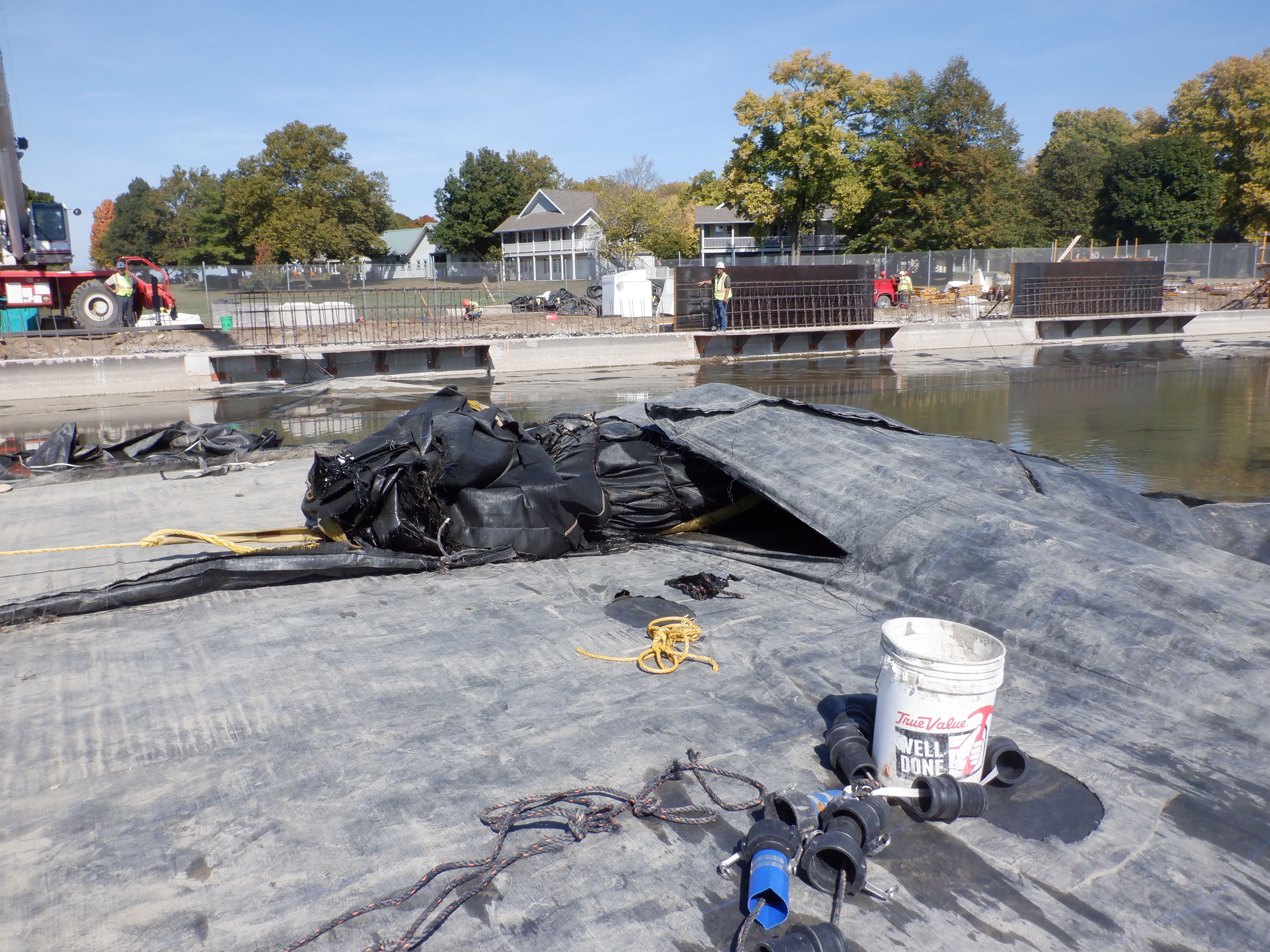
For this connection, workers created a single access hole to draw the fill-tubes and open end through the collar. Under typical conditions, the open end remains positioned atop the closed end inside the collar, while each fill-tube is individually pulled up through separate, designated holes. In this case, however, the team was working with previously deployed AquaDams® and had to adapt the procedure to suit site-specific constraints and material conditions.
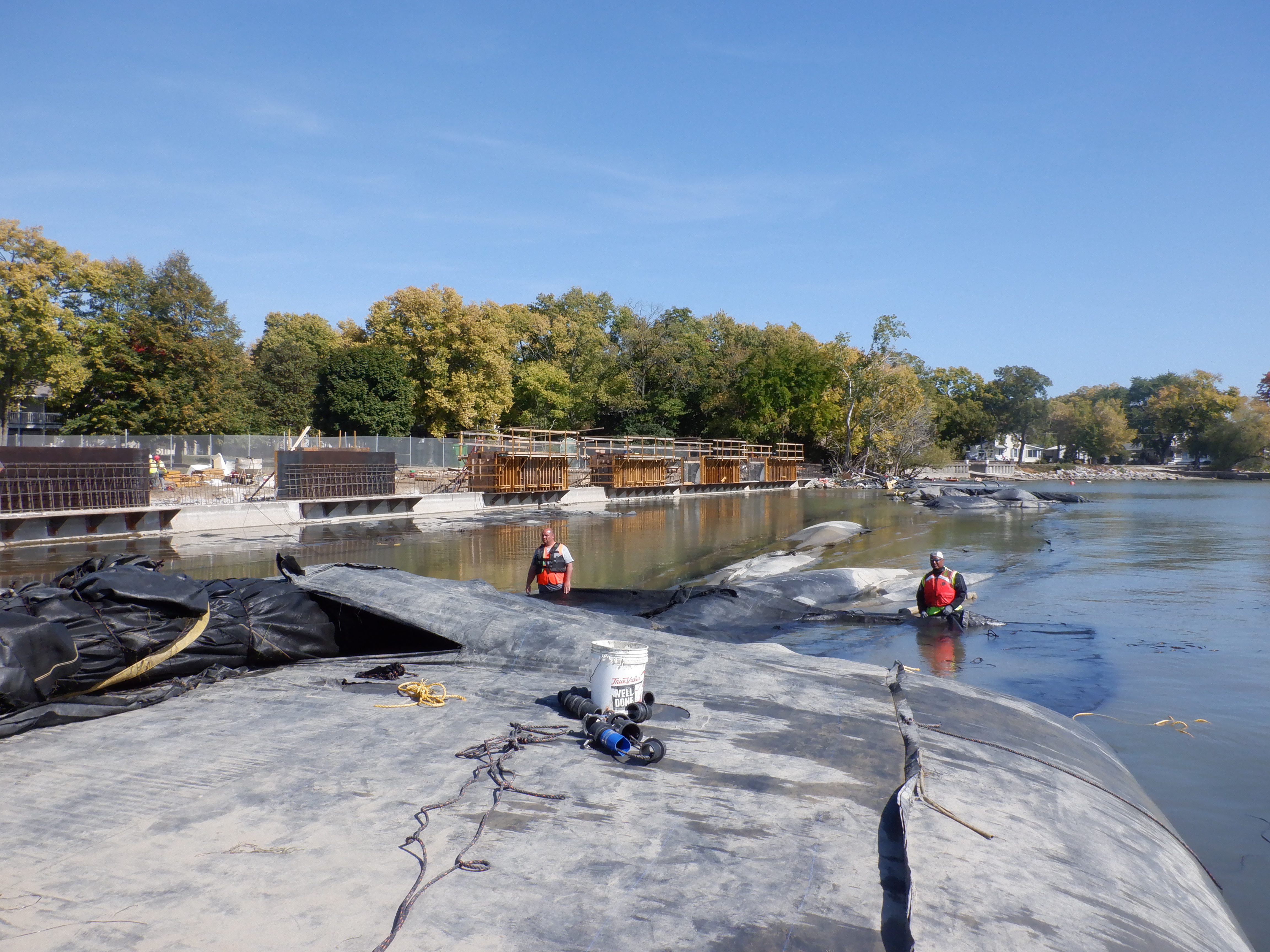
Once sufficient material has been pulled through the connection collar, workers will insert discharge hoses into the fill-tubes to begin filling the unit.
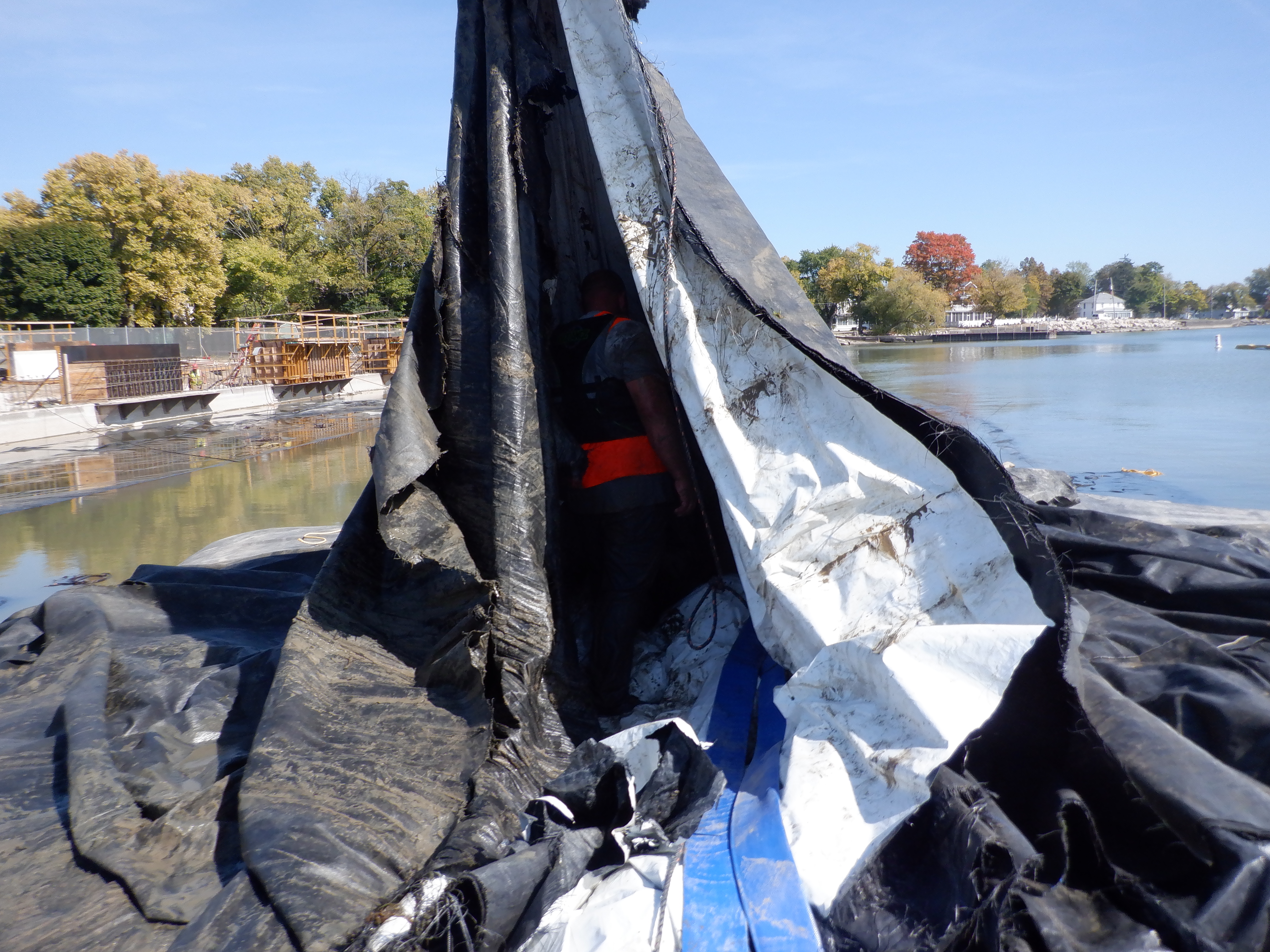
Workers inserted two 3in blue discharge hoses into each fill-tube. The hoses were positioned far enough inside the fill-tubes to extend down to the closed end of the AquaDam® it was being connected to.
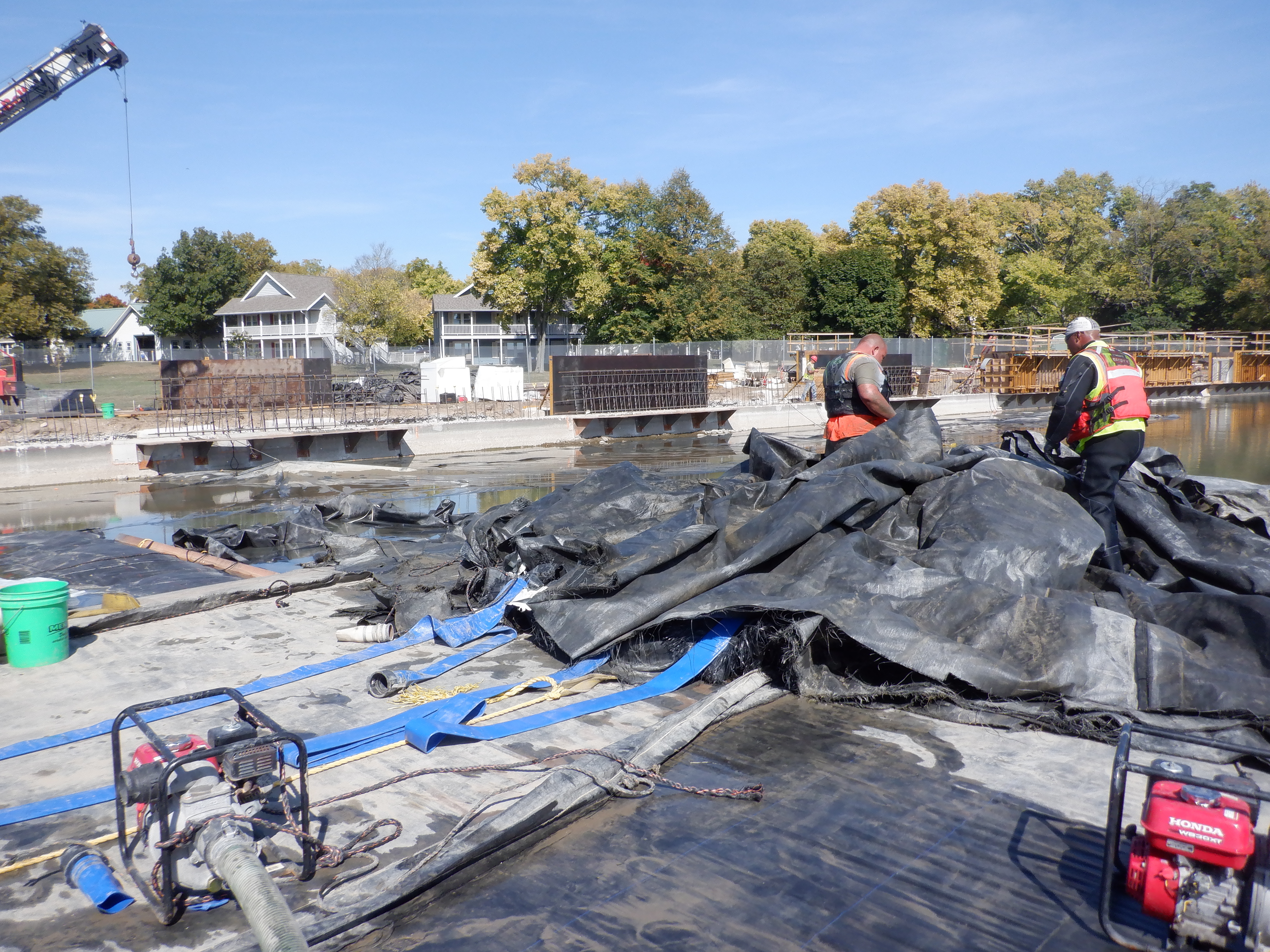
A 14ft tall AquaDam® is constructed with 12 layers of material: two layers of impervious polyethylene and ten layers of woven polypropylene. After the discharge hoses were inserted into the fill-tubes, workers cleared and organized the loose material surrounding the fill-tubes to prepare for filling operations.
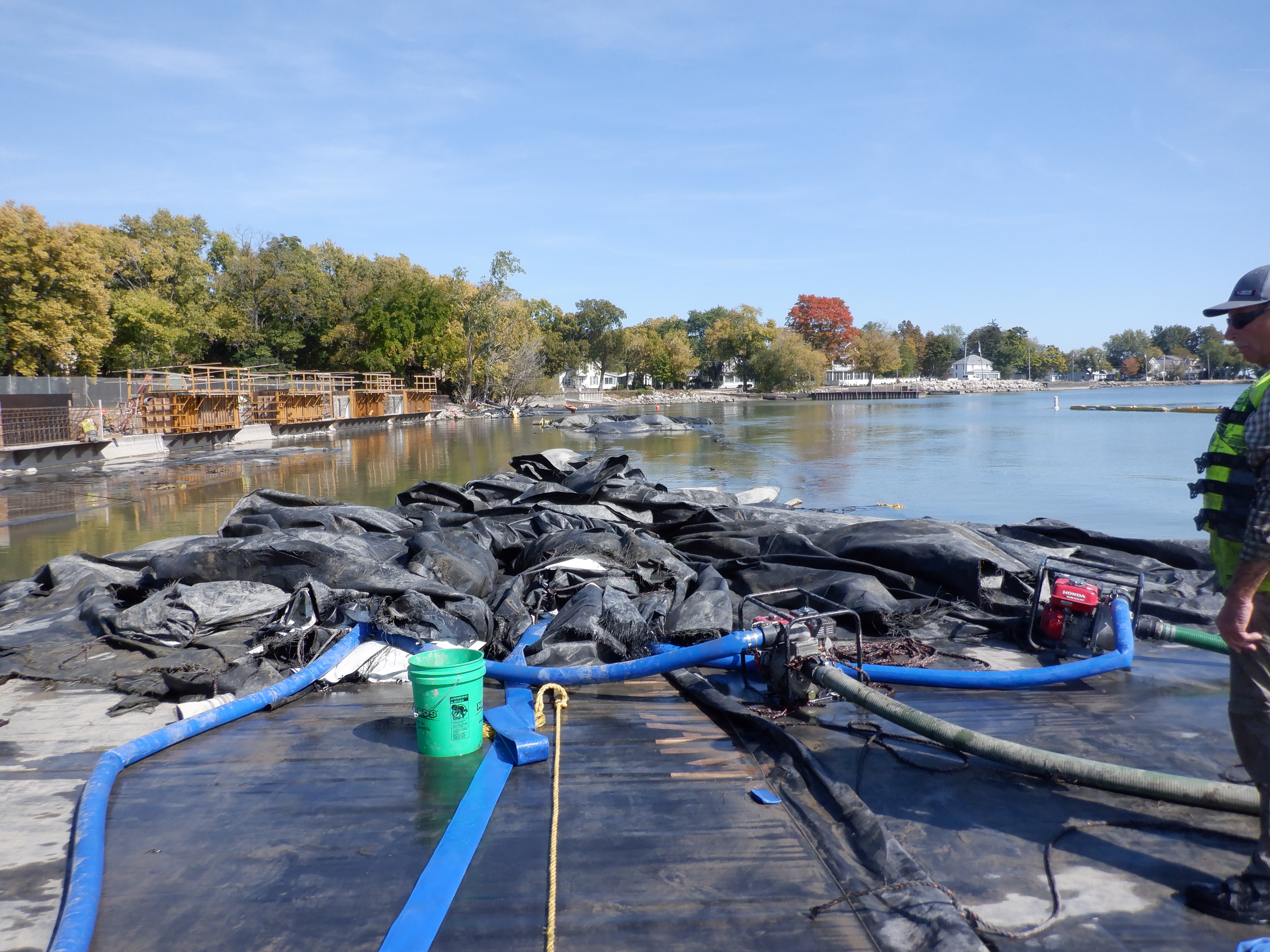
To ensure balanced inflation, workers have initiated two pumps. The recommended practice for an AquaDam® is to achieve simultaneous and equal filling from both sides.
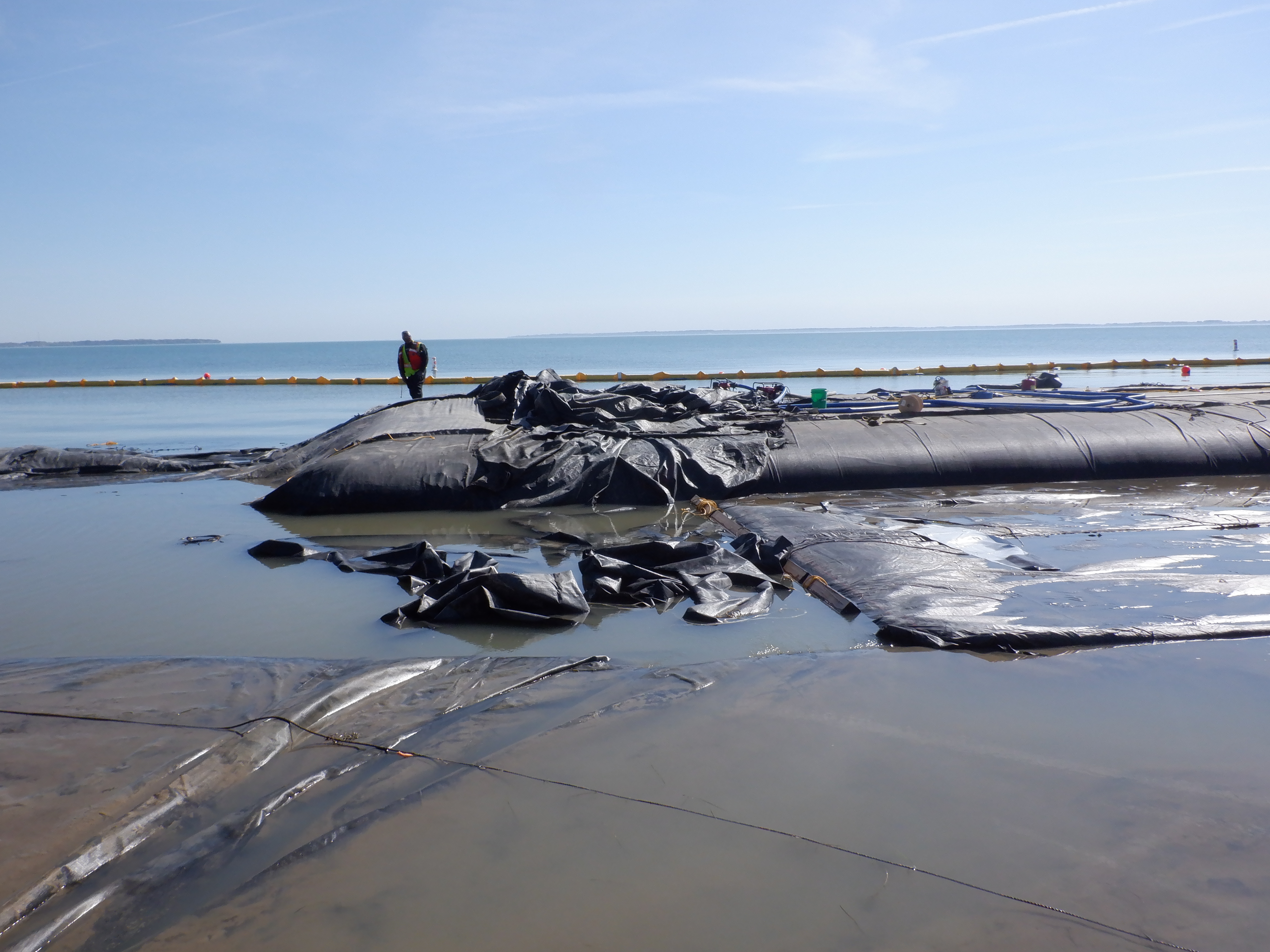
The closed end of one AquaDam®, equipped with a connection collar, serves as the starting bank for the subsequent AquaDam® unit. This structural arrangement enables a secure junction between segments, allowing the next dam to be positioned and inflated directly against the anchored closed end. Proper alignment at this interface is essential to maintain hydraulic integrity and ensure continuity throughout the water control system.
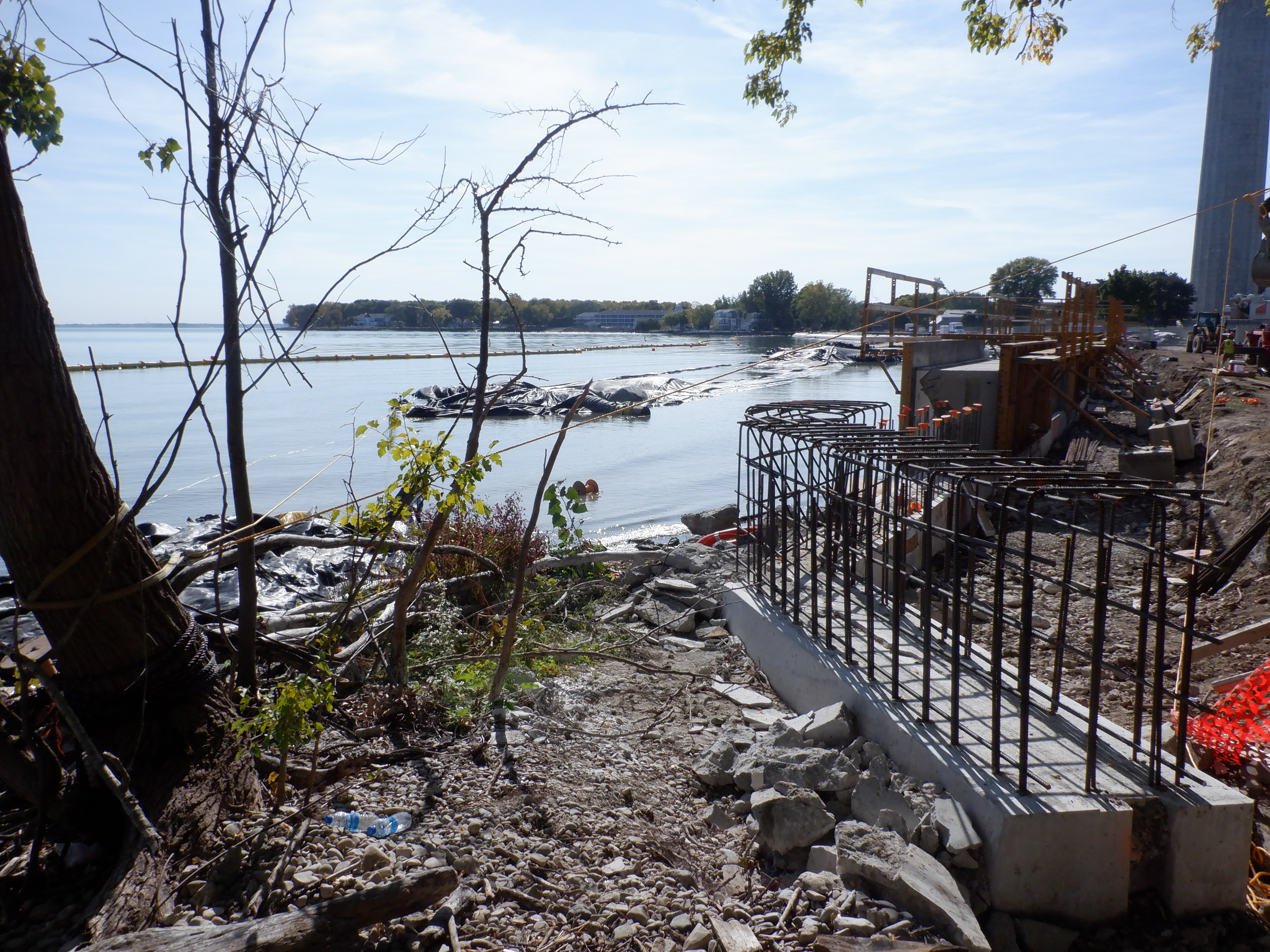
To properly position the fourth 14ft tall SCE AquaDam®, workers needed to reconfigure its rolled-up closed end. This maneuver was facilitated by the use of ropes and pulleys.
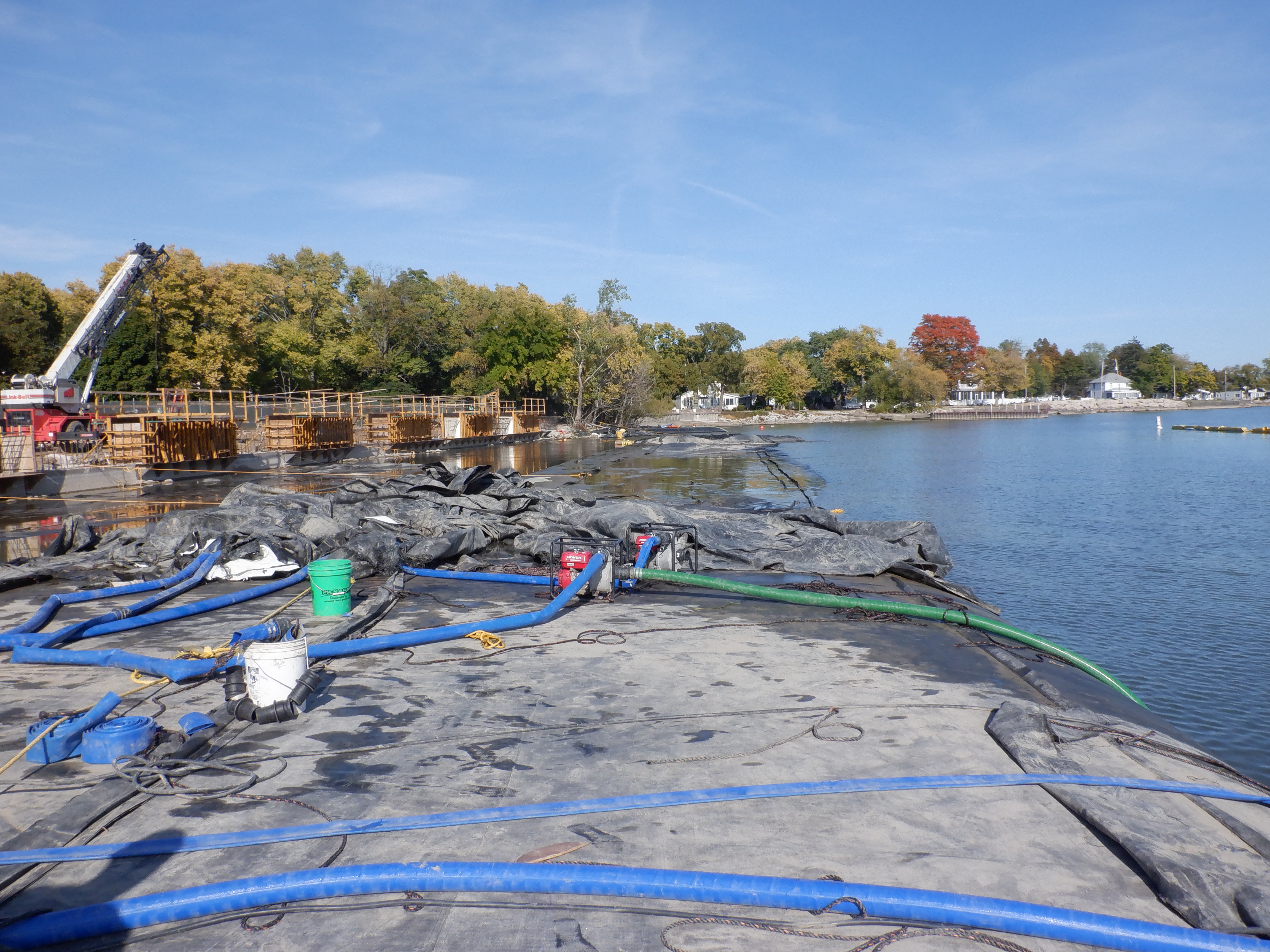
Four 3in pumps are actively filling the fourth 14ft tall SCE AquaDam®. To prevent lateral movement during inflation, workers have secured ropes from the top center seam of the AquaDam® to immovable anchors on shore. This anchoring method stabilizes the structure as it inflates, helping maintain alignment with the previously installed section and ensuring the dam remains properly positioned throughout the fill process.
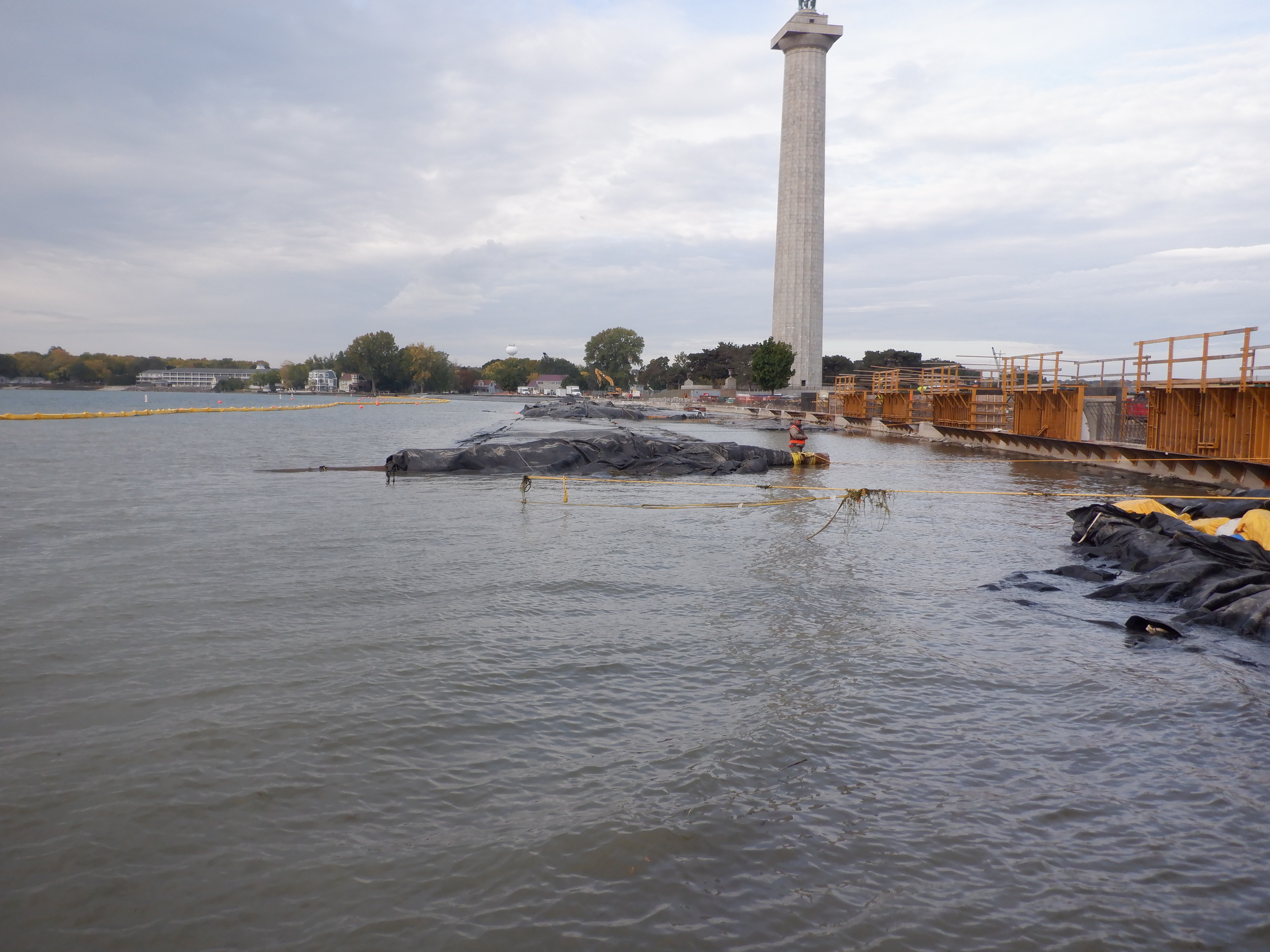
Workers secured ropes to the wooden beam around which the AquaDam® was rolled. By strategically wrapping the ropes, they created a rigging system that, when tension was applied, caused the beam to rotate and progressively unroll the dam. This technique provided controlled deployment of the unit.
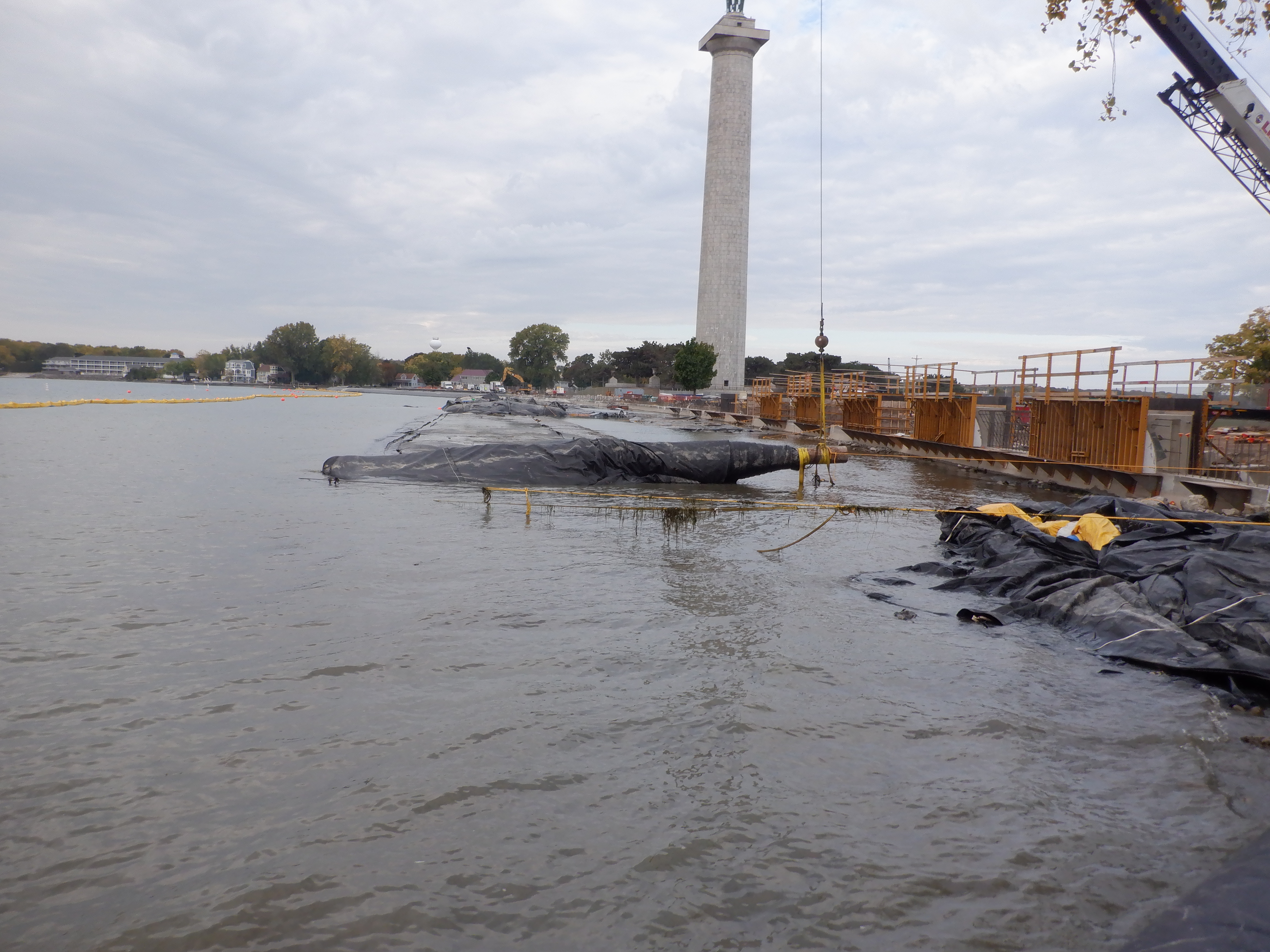
Due to the significantly shallower water depth on the right side, a crane was employed to assist in maneuvering that end of the AquaDam®. This approach provided essential lifting force, helping to maintain alignment and stability during deployment, especially where manual positioning proved challenging.
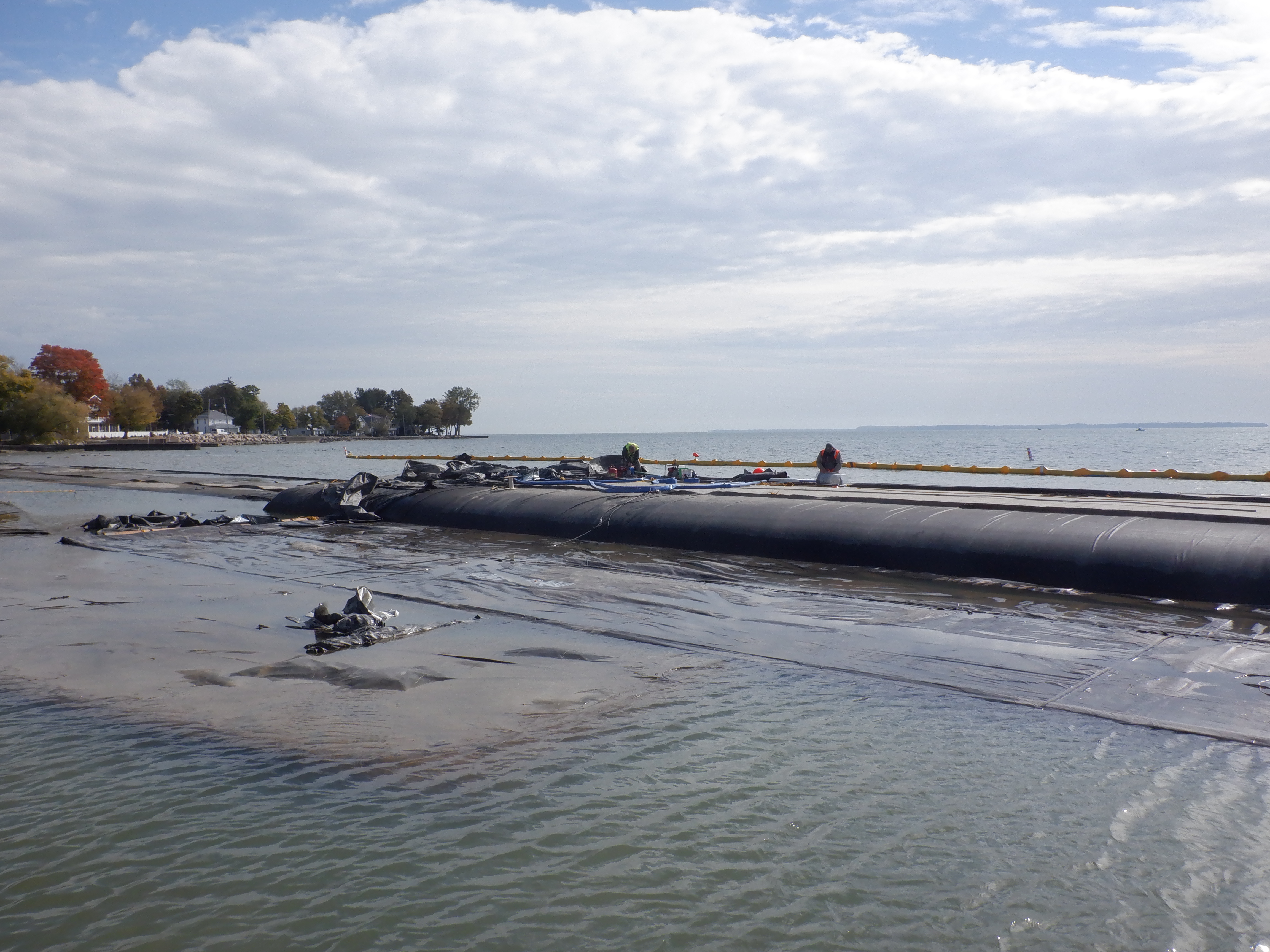
Two of the four pumps used to fill the fourth 14ft tall SCE AquaDam® were submersible. To mitigate the risk of clogging, workers constructed a screen cage and placed the submersible pumps inside. This precaution helped filter out debris and ensured continuous, unobstructed water flow during inflation.
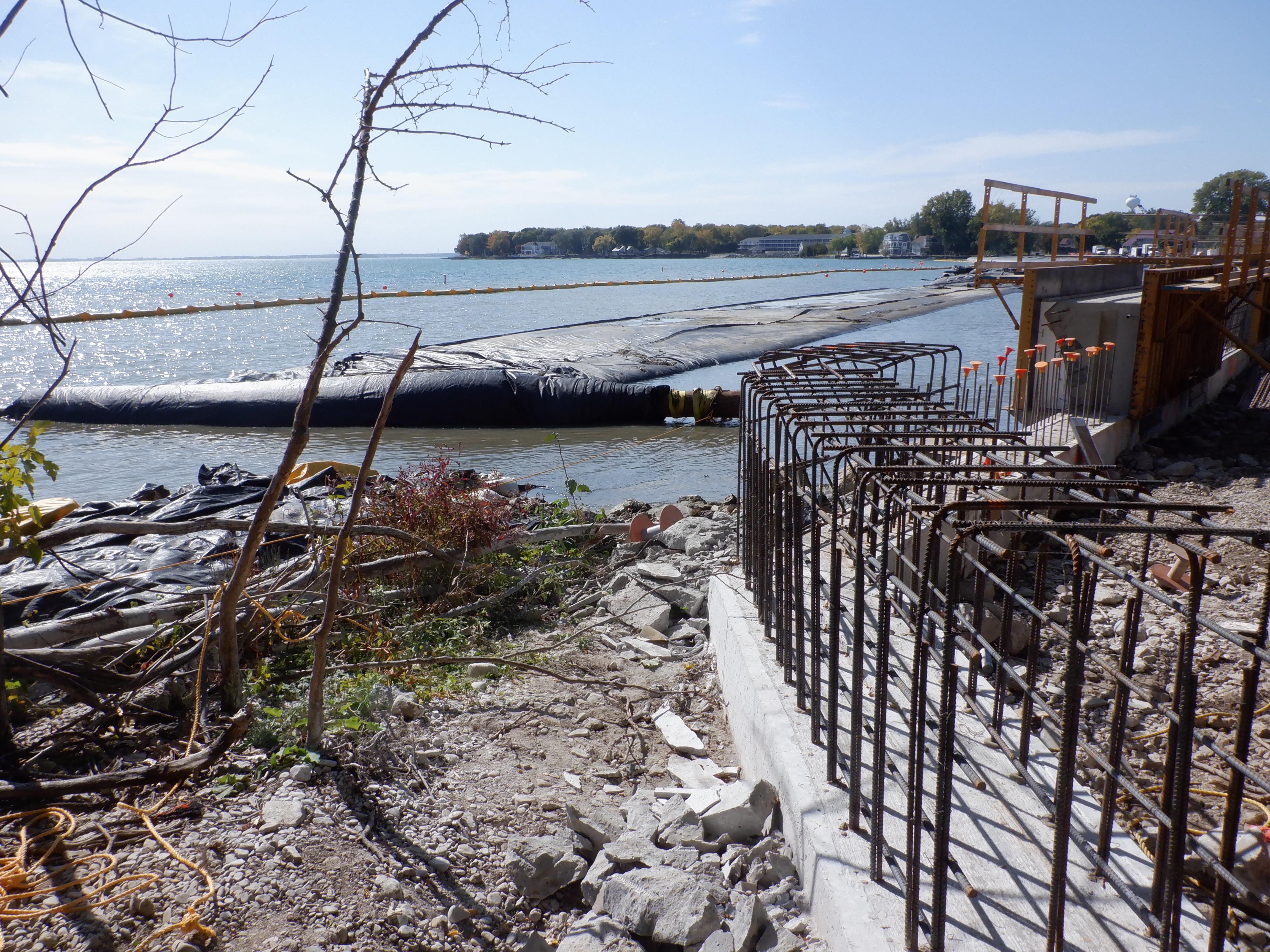
As the fourth 14ft tall SCE AquaDam continues to fill, workers are actively maneuvering its rolled end into the desired position.
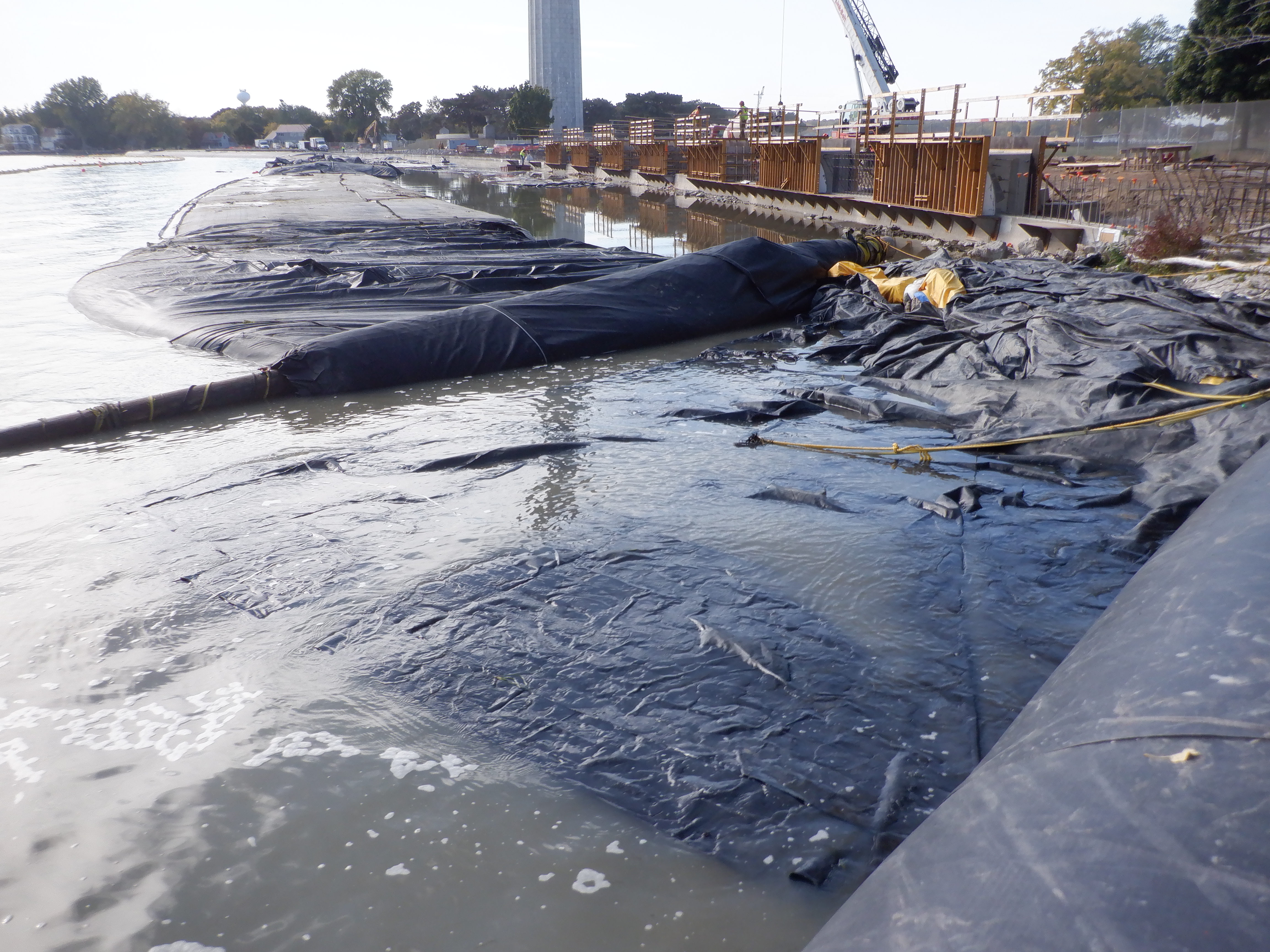
To complete the closure of the cofferdam system, the right side of the AquaDam® had to be pulled up and over uneven high ground. This final maneuver required coordinated effort and precise handling to ensure a secure seal across the variable terrain, minimizing potential gaps and maintaining structural integrity.
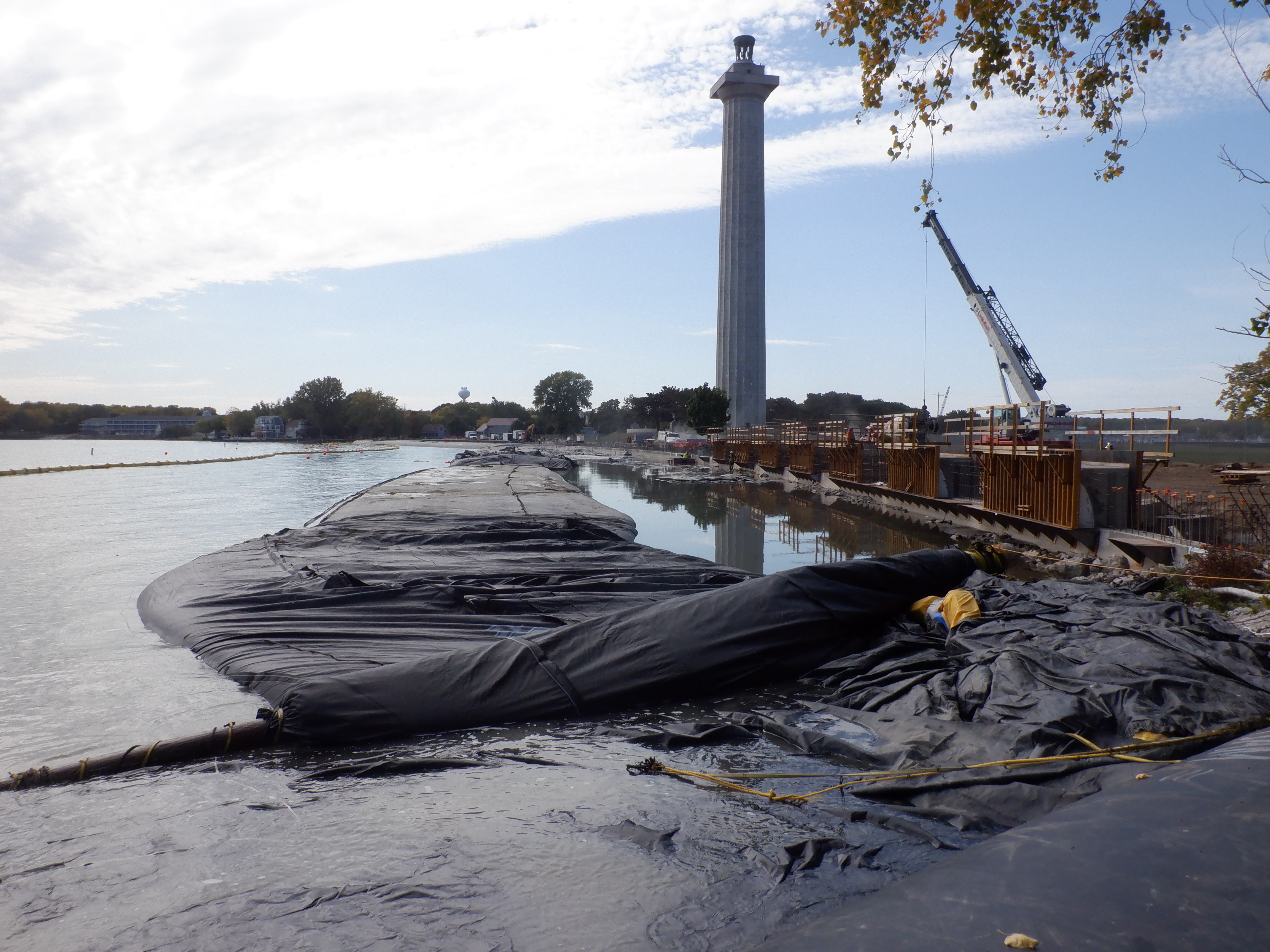
As water filled the AquaDam®, internal pressure caused the roll to progressively uncoil. To guide its positioning, workers used ropes to steer the dam into the desired location, maintaining directional control throughout the unrolling process.
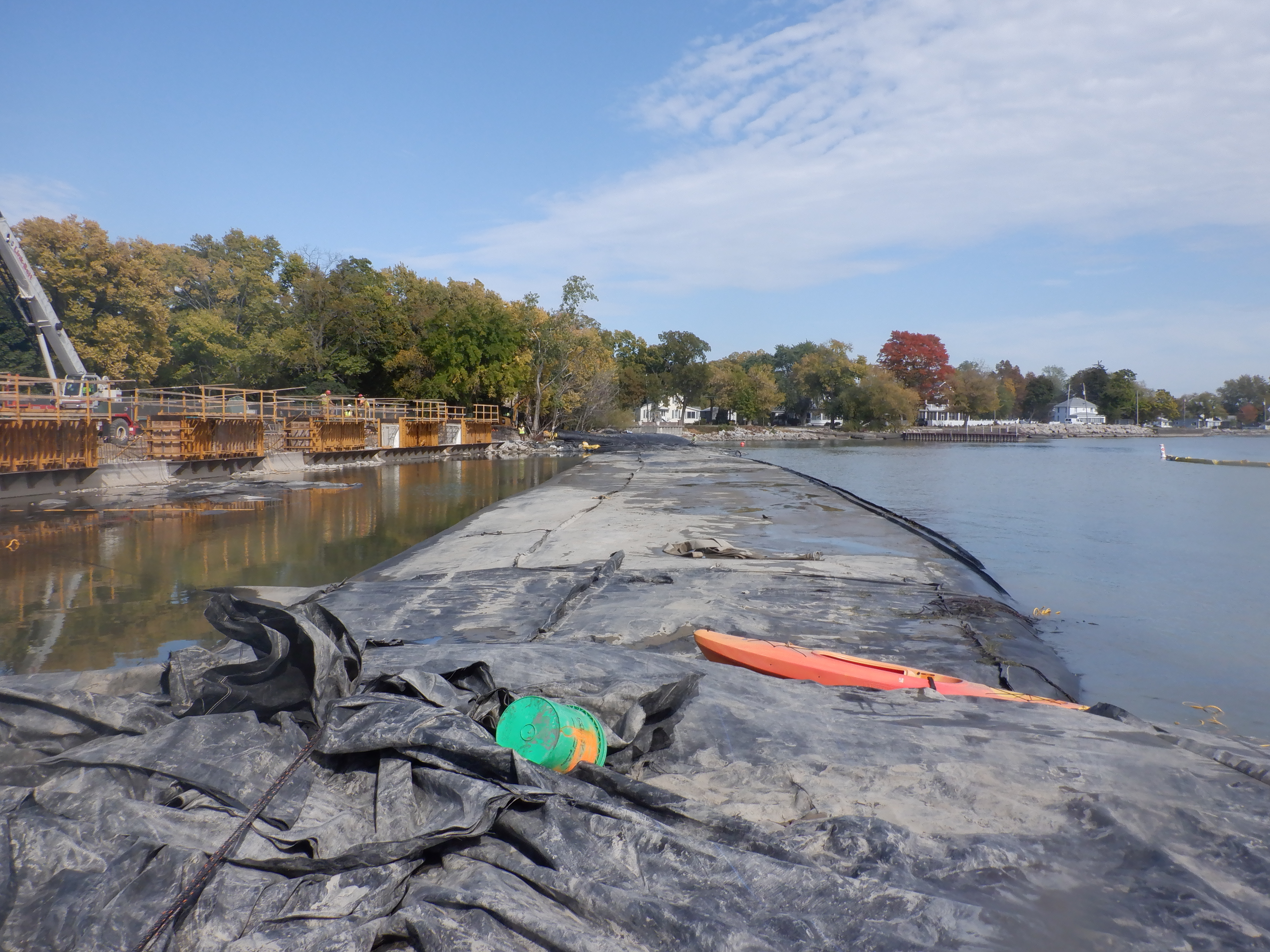
The fourth 14ft tall SCE AquaDam® is actively filling with water. Prior to this installation, the unit remained partially empty and submerged for several days, resulting in a coating of silt along its exterior surface.
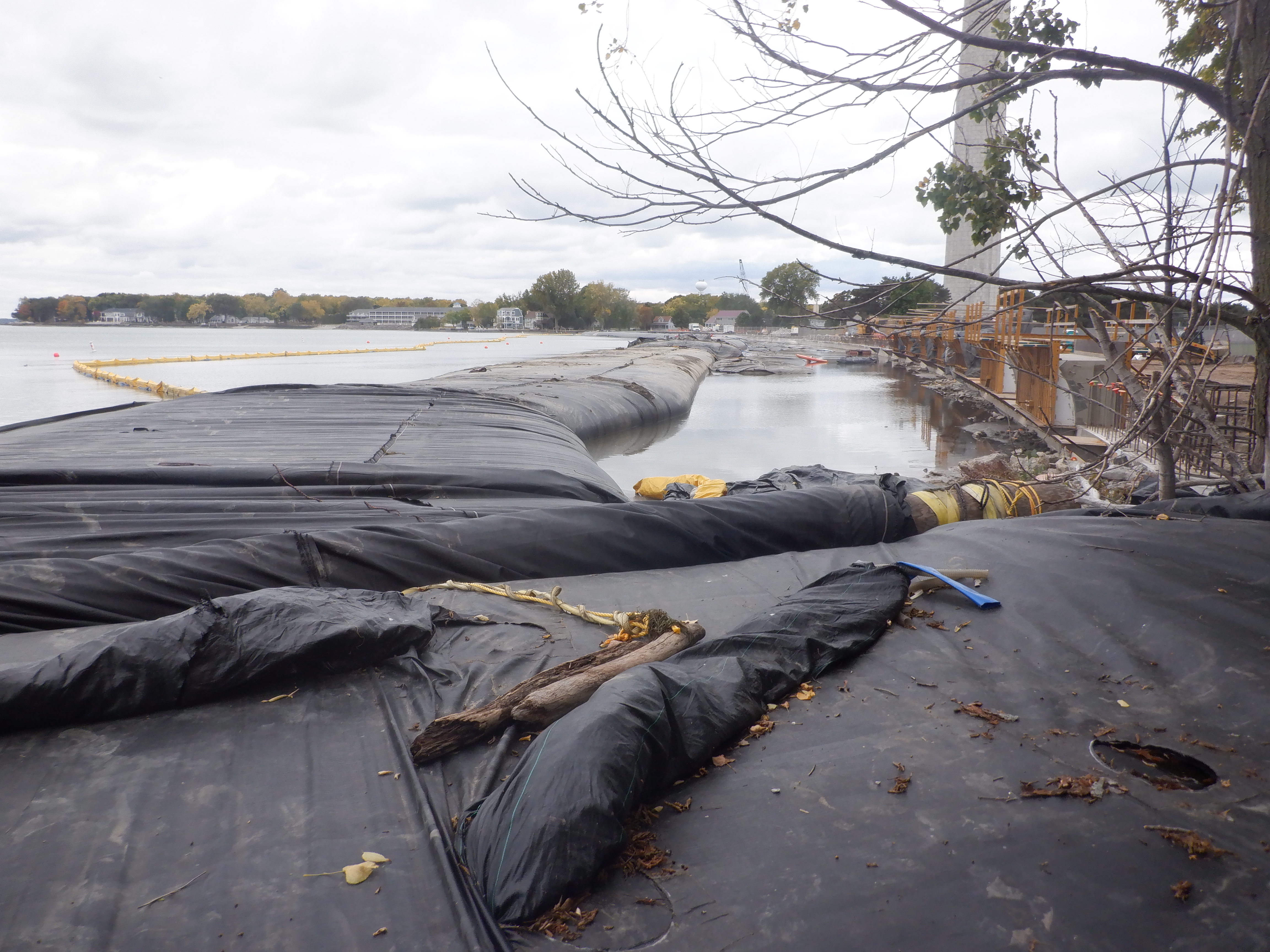
The roll end of the fourth 14ft tall SCE AquaDam® successfully uncoiled onto the 12ft tall DCE AquaDam®, completing the seal between the lake and the sea wall. This final connection established the cofferdam’s perimeter, isolating the worksite from external water sources and enabling controlled conditions for subsequent operations.
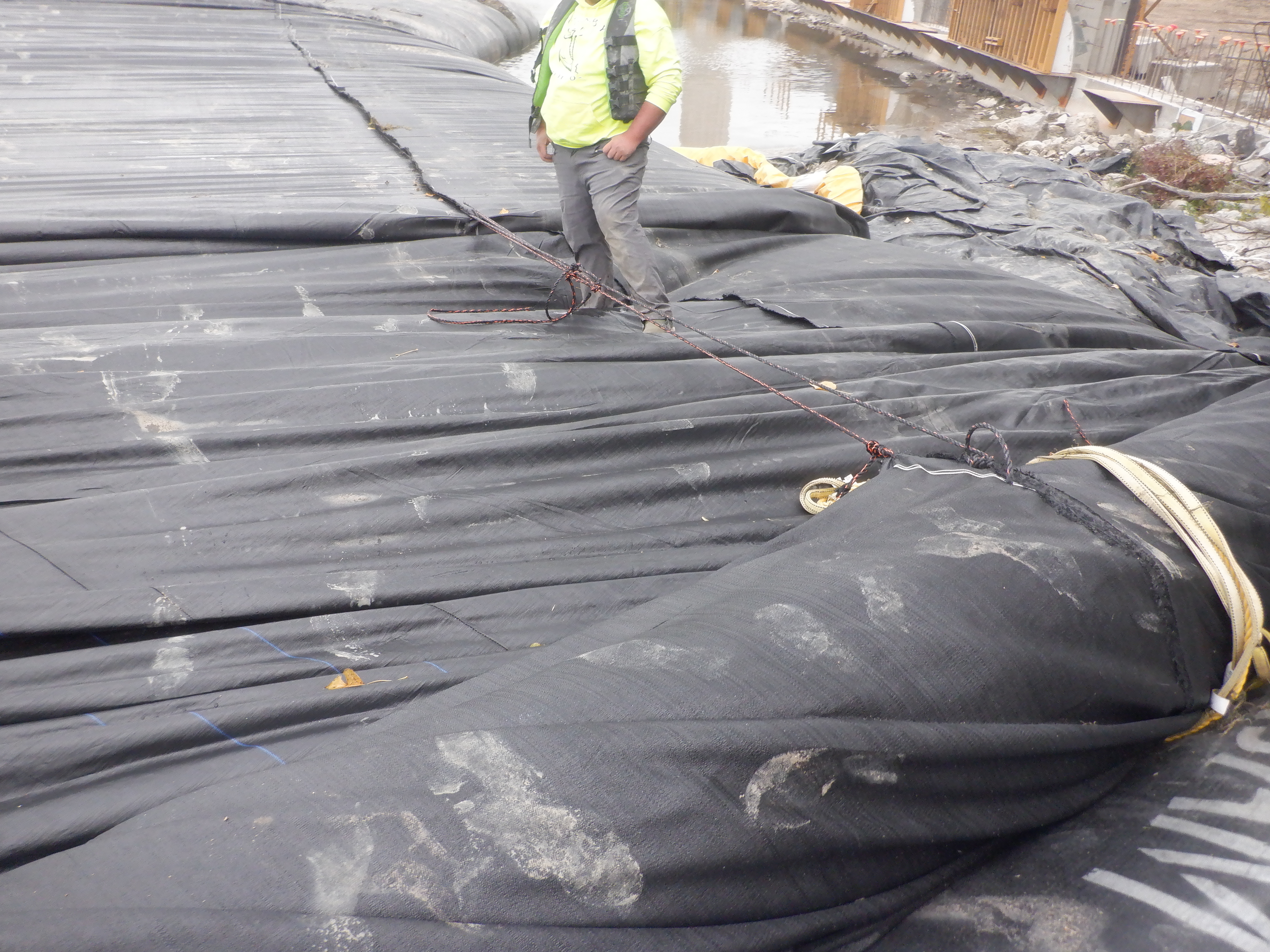
To prevent further unrolling of the AquaDam®, workers secured ropes between the upper and lower seams, anchoring the roll in place.
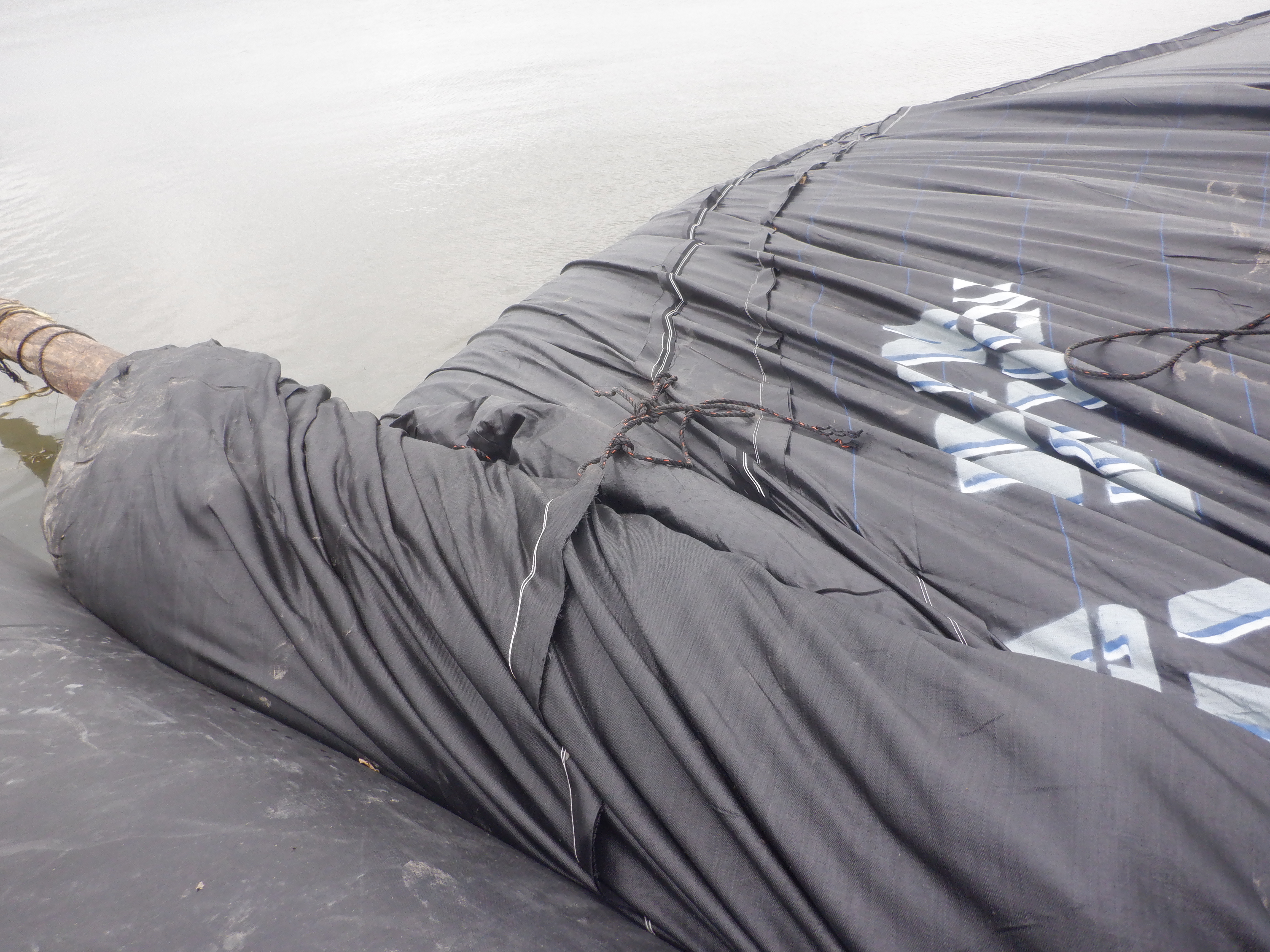
A secondary rope was secured between the top and bottom seams at this end as well, providing additional restraint to prevent the roll from further uncoiling.
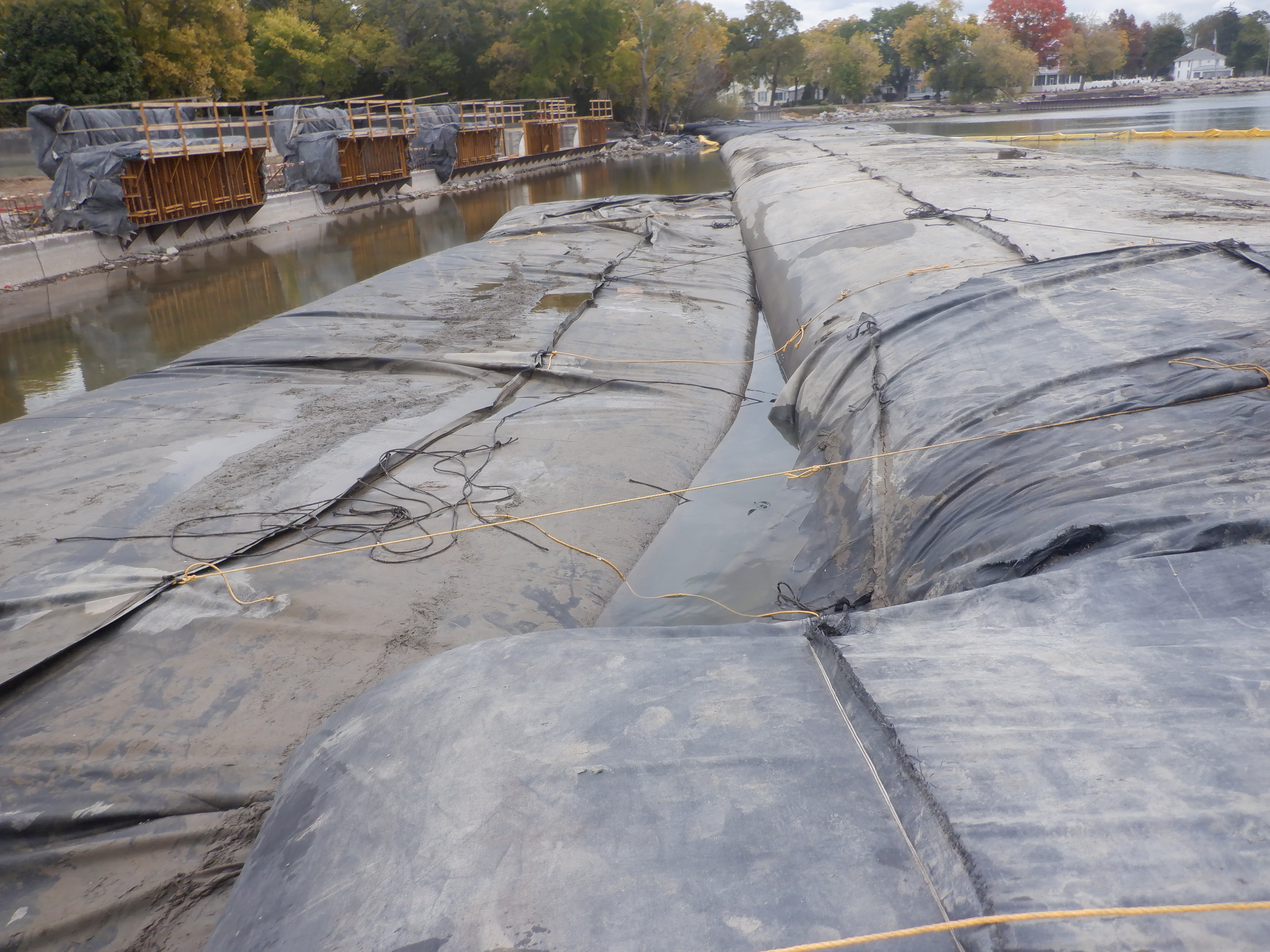
With the main AquaDam® cofferdam system in place, workers shifted their focus to the support dams. Ropes were secured between the main and support AquaDams® to maintain alignment while the support dams were filled.
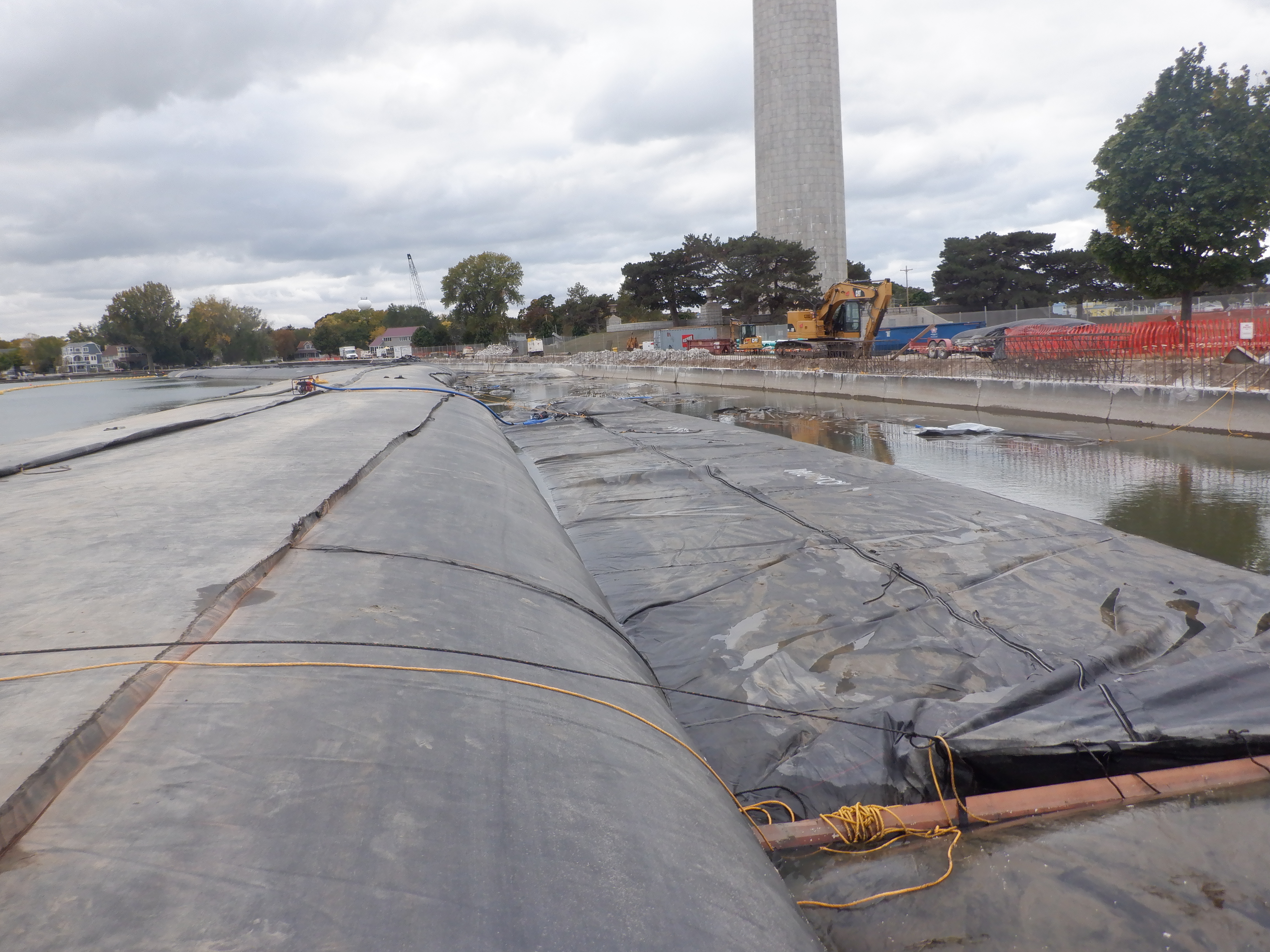
Workers prioritized filling the seawall-side fill-tube first, or applied greater pumping capacity to it, ensuring that the fill-tube nearest the main AquaDam® compressed against it as filling progressed.
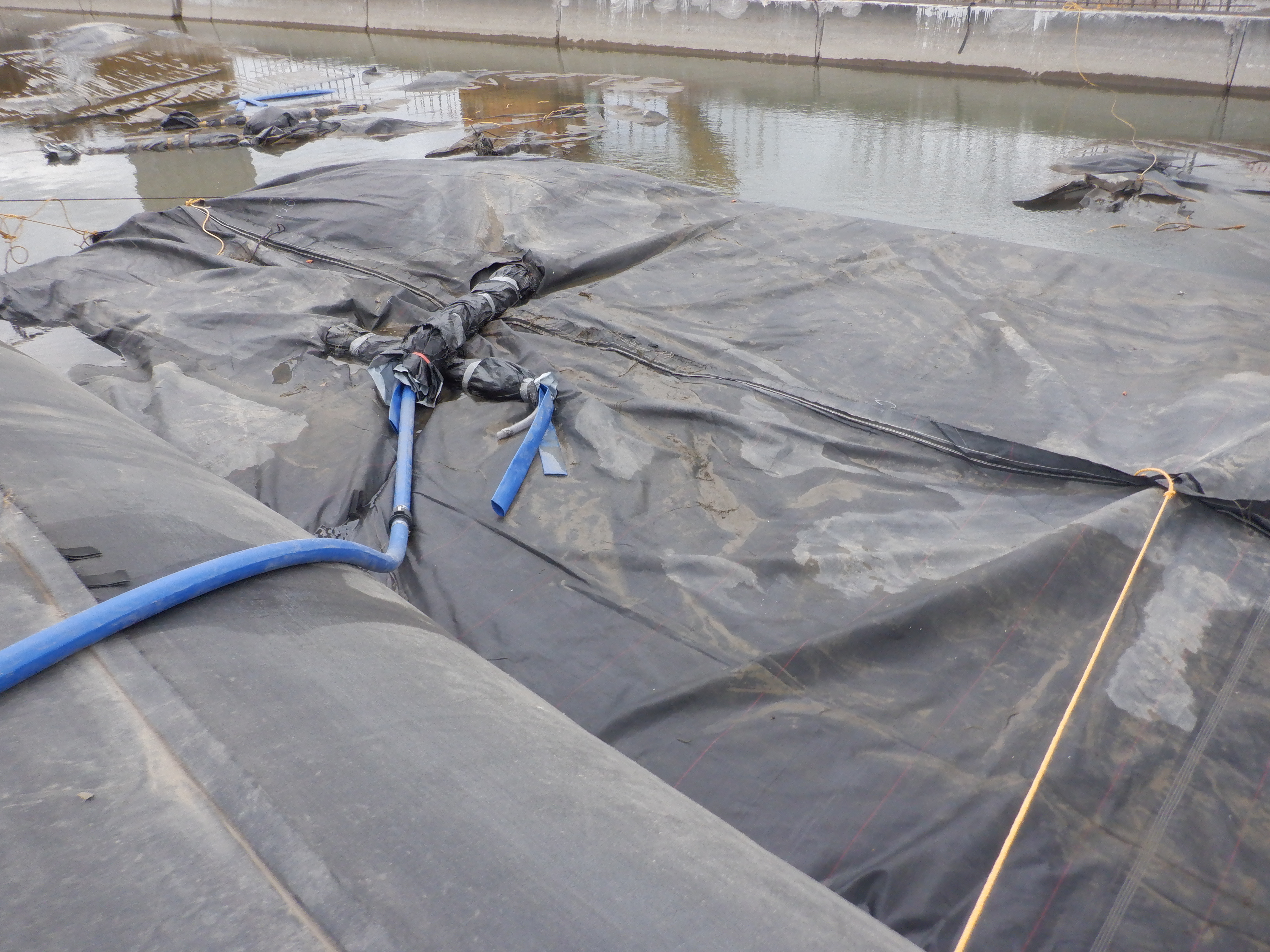
This DCE support AquaDam® has been tied back to the main system and is currently being filled from the seawall side. Positioning the unit close to the main dam and filling the outer tube first allows the inner tube to expand directly against the main system, promoting a more stable and integrated interaction.
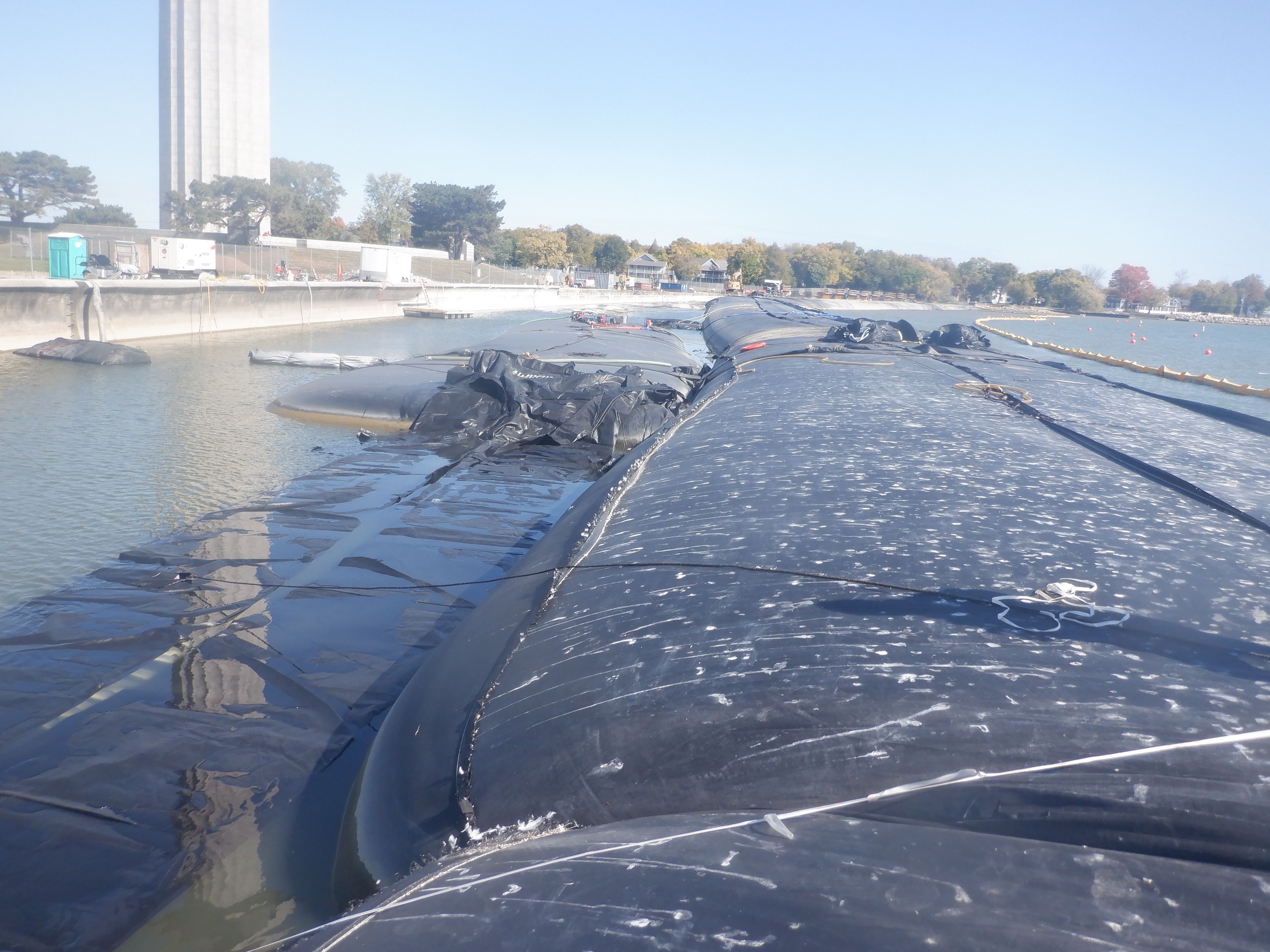
Most of the support AquaDams® used in this project were DCE units; however, a few SCE units were also deployed. This image clearly shows a SCE unit being launched from a DCE support dam.
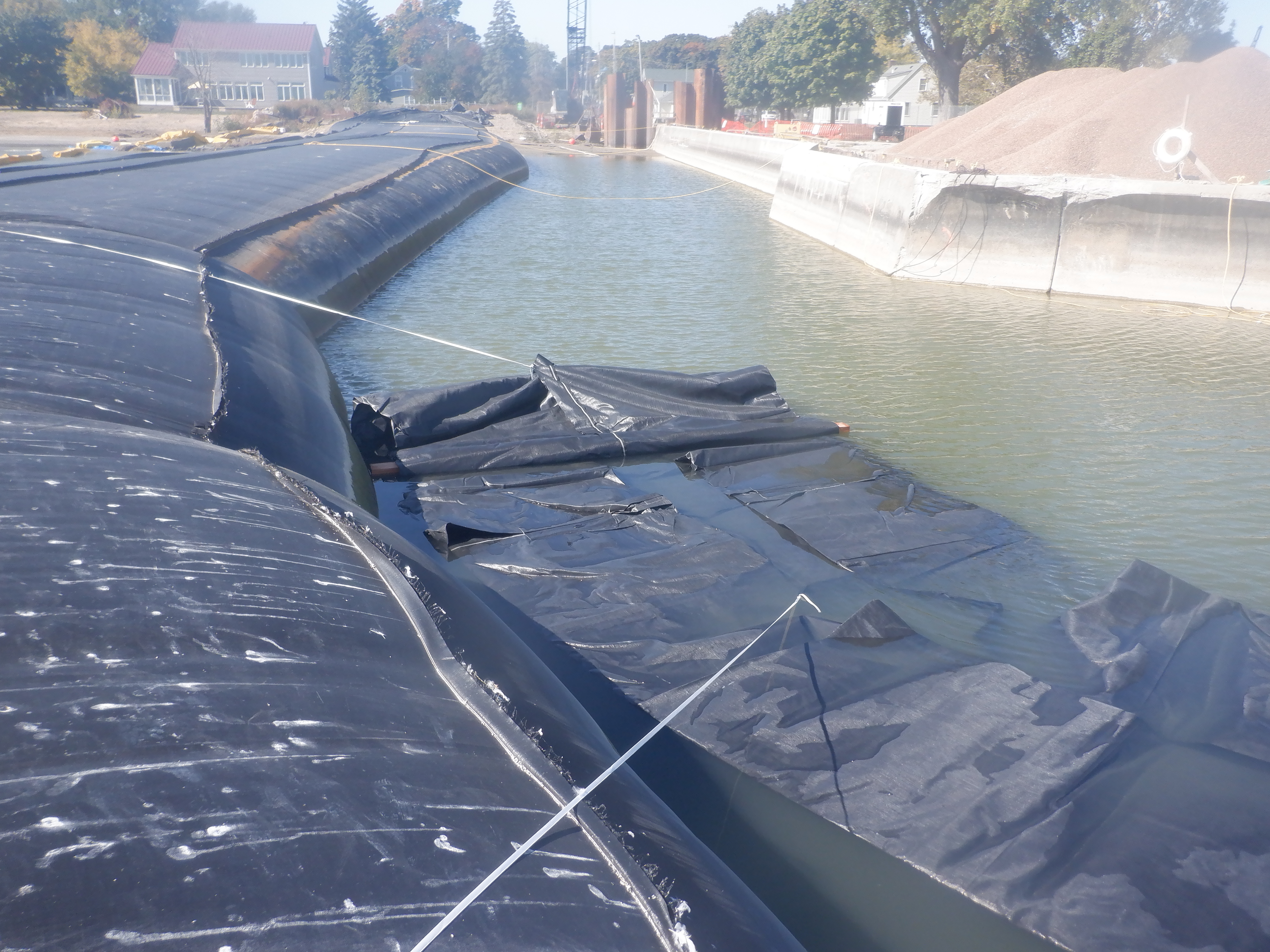
Rope is one of the most essential tools in an AquaDam® installer’s kit, valued for its versatility in positioning, securing, and adjusting dam components during deployment.
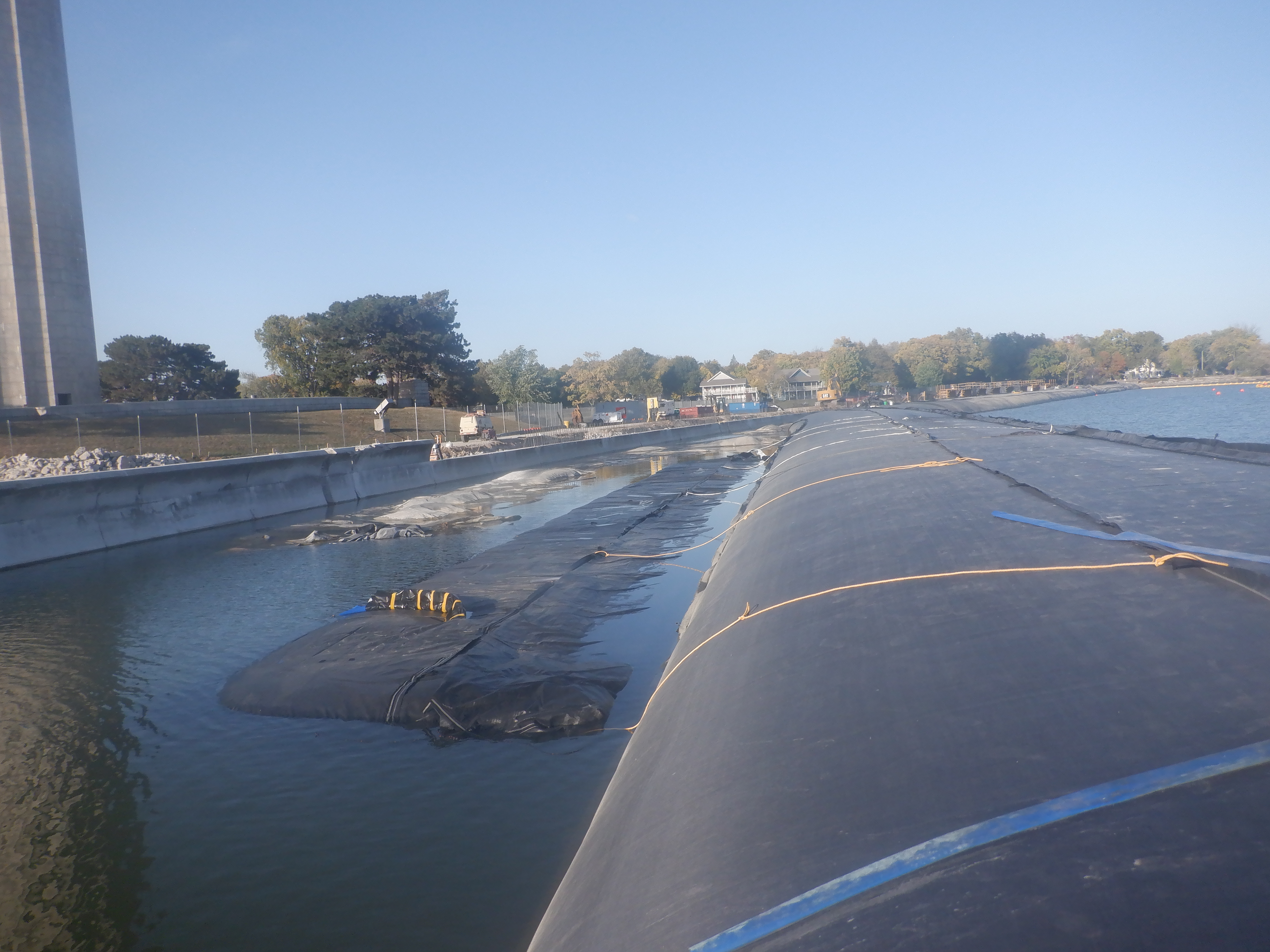
Once all support AquaDams® were installed, workers began de-watering the work area to prepare for the next phase of construction.
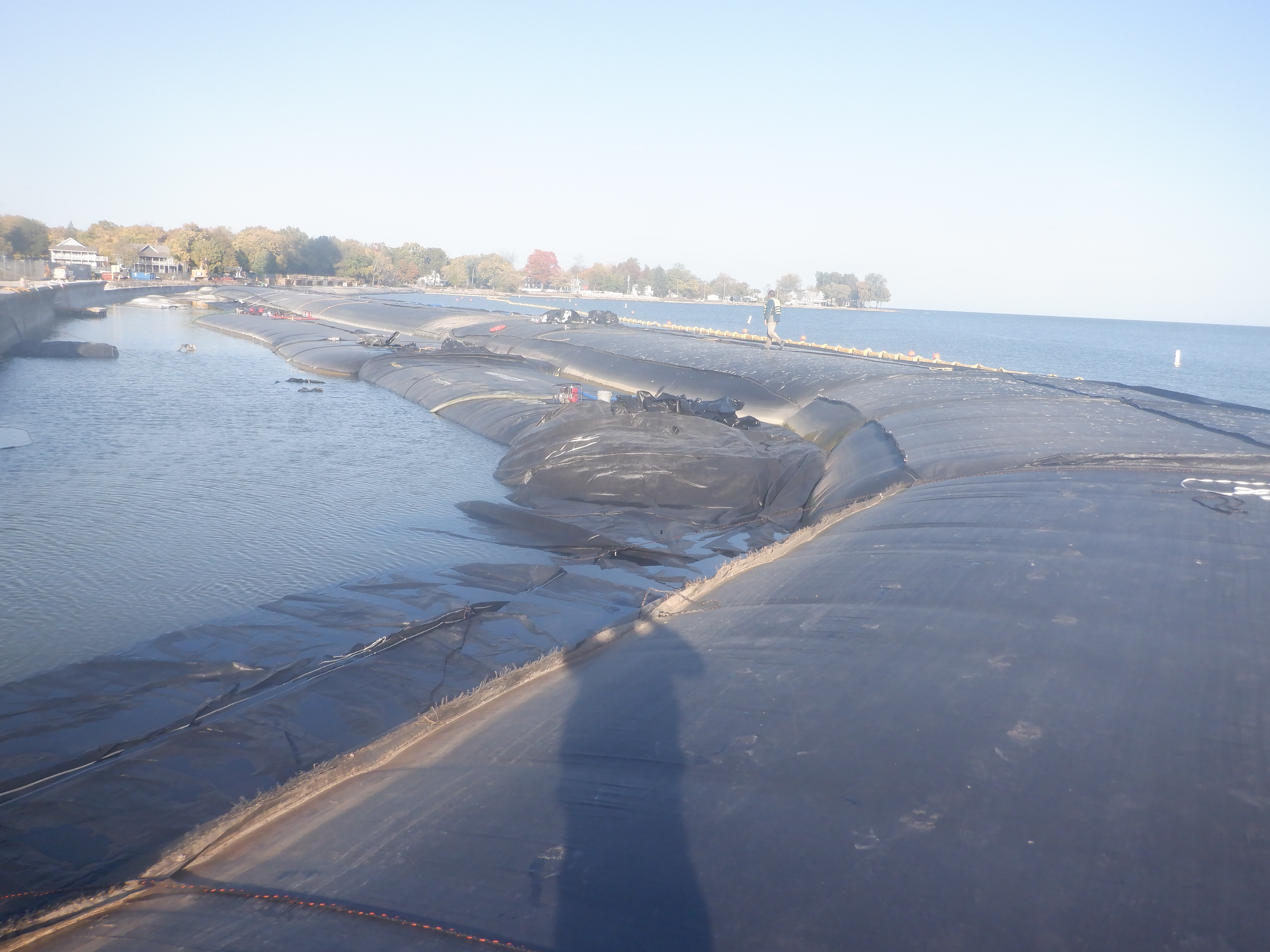
A second SCE AquaDam® was deployed as a support dam for this project. Constructed from lightweight and flexible materials, AquaDams® can be easily maneuvered into a wide range of configurations to accommodate site-specific requirements.
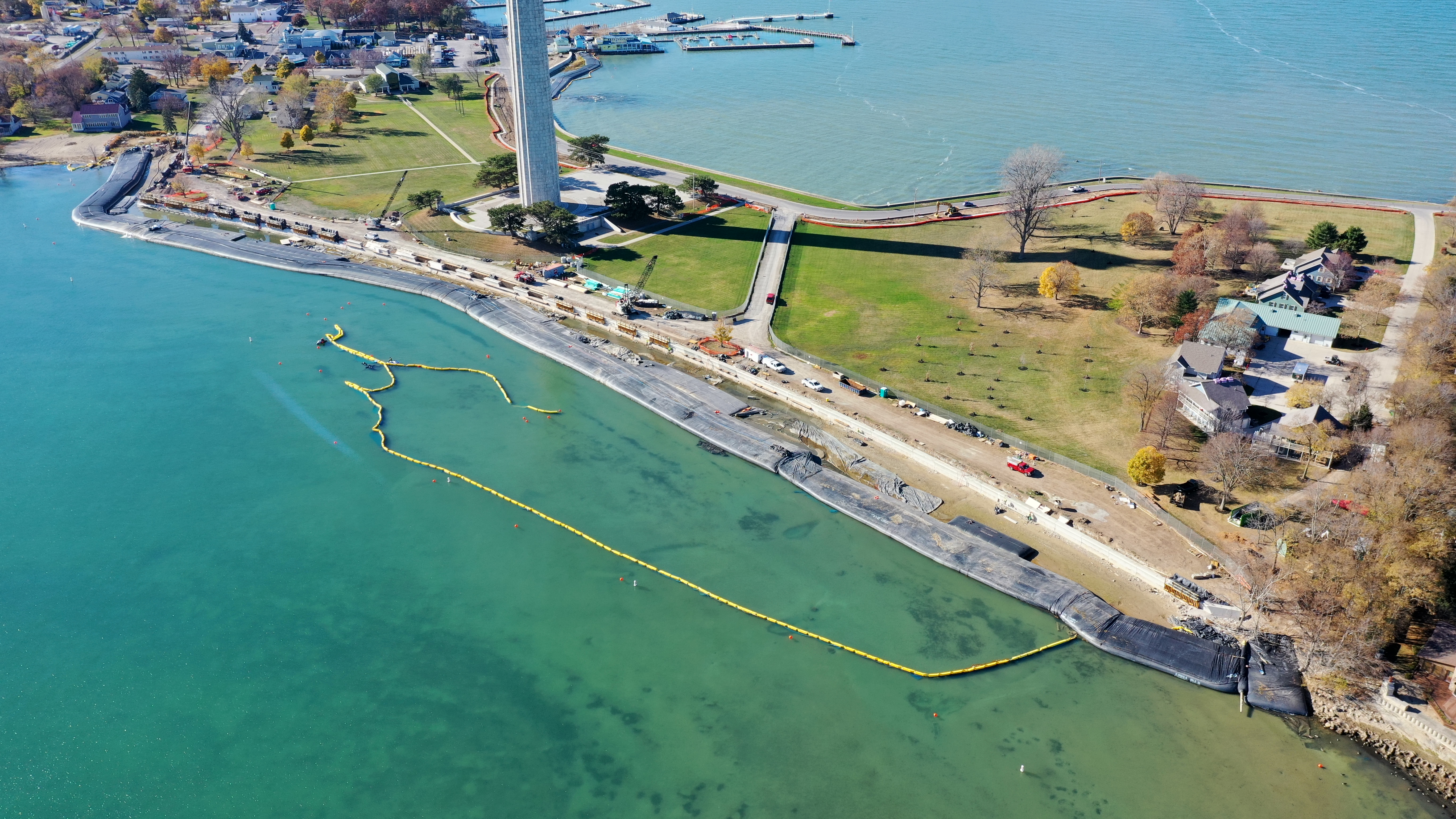
Aerial view of the fully installed AquaDam® cofferdam system, over 1,600ft long and 14ft tall, demonstrating excellent performance in water control and site protection.
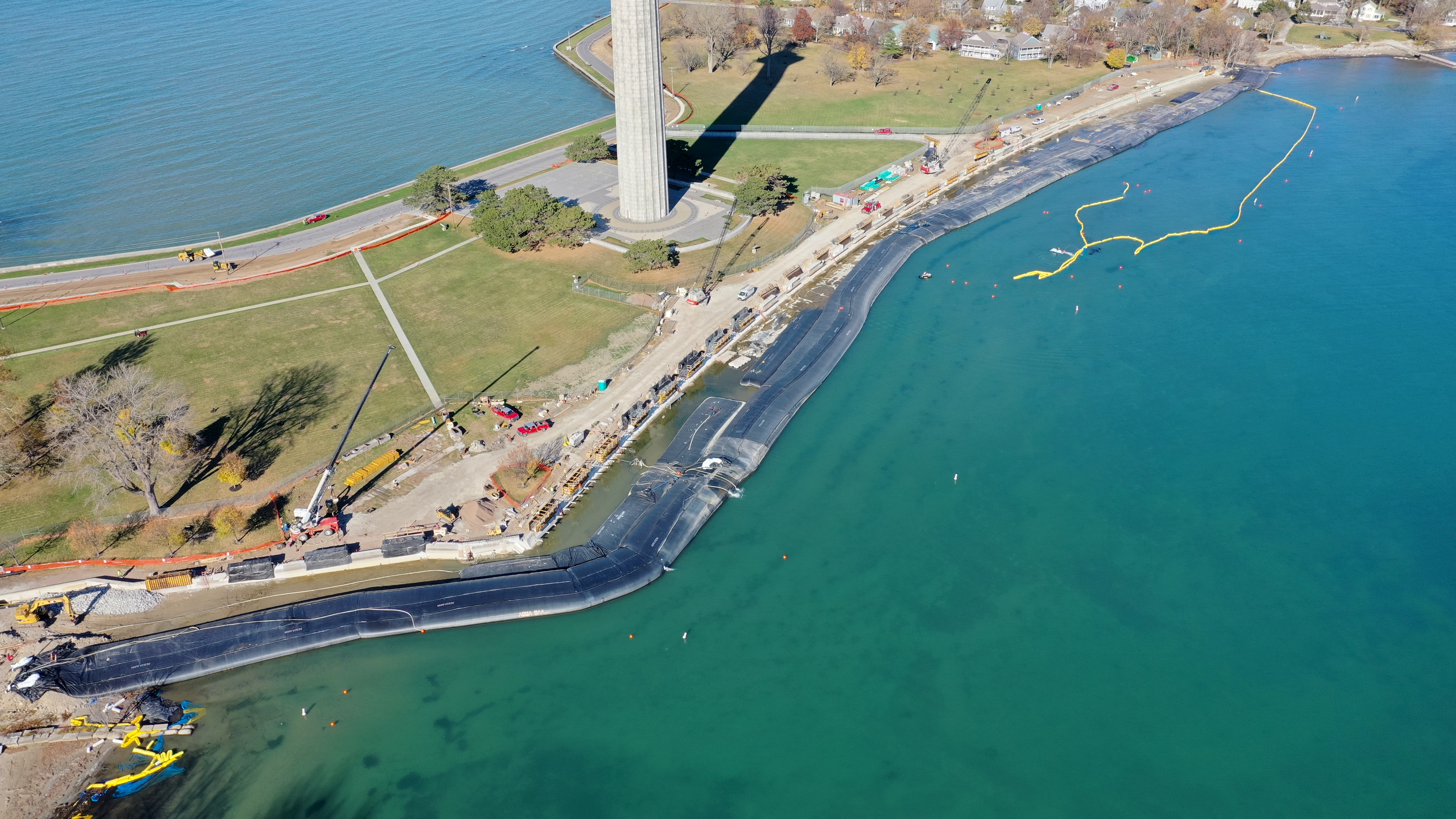
Fantastic job AquaDam®!
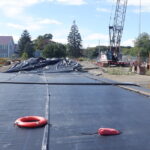
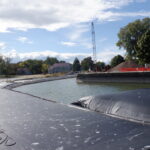
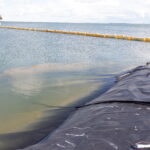
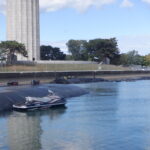
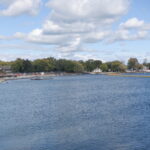
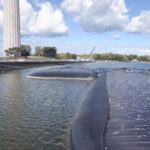
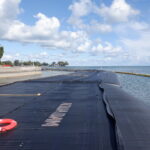

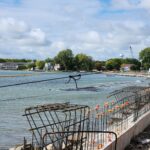

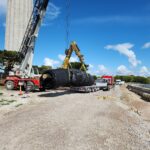
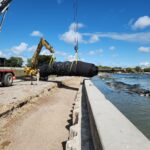
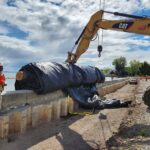
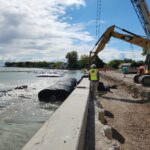
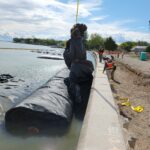
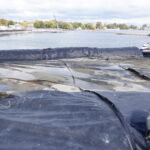
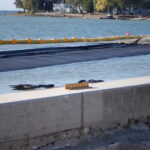
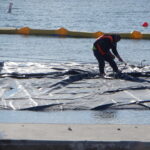
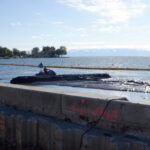
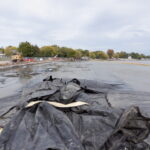
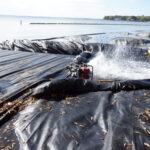
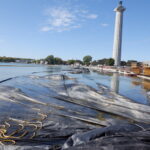
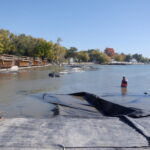
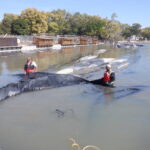
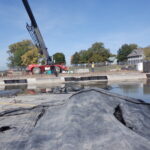
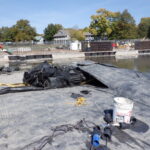
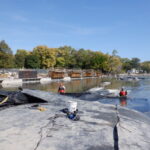
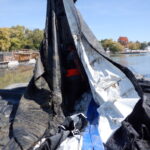
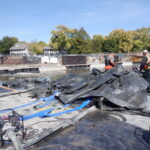
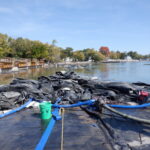
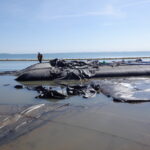
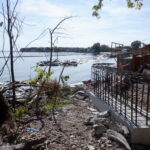
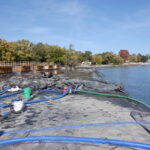
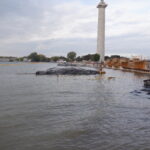
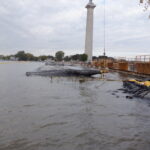
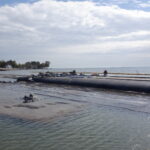
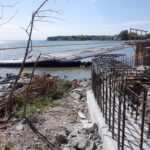
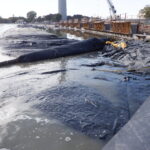
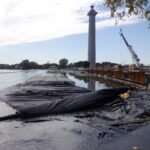
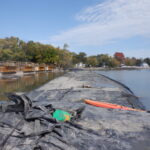
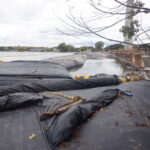
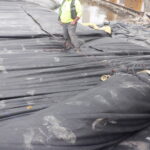
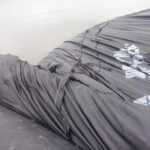
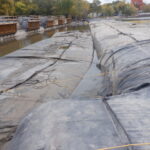
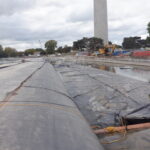
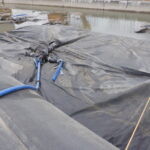
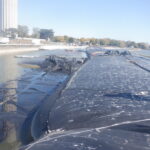
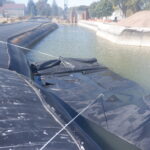
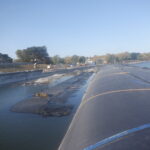
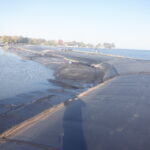
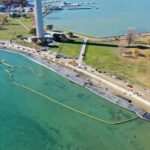

Four 14ft Tall 29ft Wide (fully filled) 450ft Long Single Closed End (SCE) AquaDams®, Lake Erie, Perry’s Victory International Monument, ES Wagner Company, Sea Wall Repair, Wave Action, Horseshoe/”U” Shape Configuration.
